20 Presentation Tips to Keep Your Audience Engaged from Start to Finish


Business | Marketing | Nonprofits | Students | Teachers
By kai tomboc - january 14, 2020.
Losing the audience’s attention is one of the most painful challenges for anyone making a presentation.
Halfway through your presentation, you notice that a couple of audience members are getting restless. The people at the back seem bored as they look down on their phones, and one of them just yawned (ugh!).
You start to feel that you failed to engage your audience. You wonder if you’re the problem. Are you a boring presenter? Perhaps you’re stuffing too much information in your slides.
Master audience engagement with these presentation best practices
From engaging product demos to presentation decks that stand out, read on for 20 valuable tips to keep your audience excited to hear more from you.
What makes a great presentation?
Before you get started, it pays to know what makes an excellent presentation.
1. It informs your audience by providing reliable information.
People want to be informed. They want to learn something new. For this reason, you should look for reputable links. The information should be as recent as possible, and at least less than a year old.
Your research work doesn’t need to be from online sources. You could also cite printed sources from the library. Double-check all of your sources and make sure they have substantial research and statistics to back them up.
2. It persuades your audience to take action.
A presentation should be persuasive. This is especially true for business presentations and product demos. You might also want to appeal to your readers through emotions.
3. It educates your audience and empowers them to make informed decisions.
Presentations are, by nature, educational. You might be introducing your audience to a new idea, product, or service.
4. It instructs your audience in a clear, compelling way.
A presentation should be instructional. Organize your presentation as clear and concise as possible, so your audience will be able to digest your information more effectively.
5. It inspires your audience by being memorable.
A good presentation motivates an audience to act on things that they’ve been meaning to do after hearing you speak or present.
20 best pactices for visually-appealing, convincing presentations
With all that in mind, here’s a list of useful best practices and tips for presentations that stick.
1. Know your target audience.
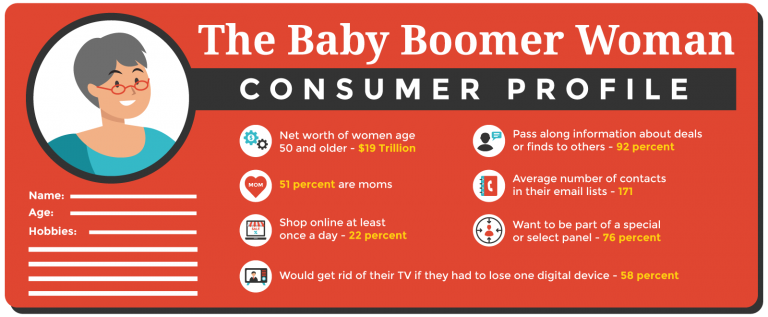
Your target audience is the demographic that you’re aiming to convince, educate, or inspire with your presentation. This crucial step helps you craft a presentation that resonates with your intended audience.
For instance, if you’d like to educate teens, create a presentation that appeals to their age group. Make your presentation more upbeat, and use pop culture references and images that they can relate to.
On the other hand, if your target audience spans middle-aged professionals, your presentation should be straight-to-the-point and based on facts. These professionals are typically results-oriented, and they want to get to the heart of the matter right away.
By and large, getting to know your target audience enables you to create a presentation without wasting time on uninterested demographics.
2. Create an outline.
Your next step is to create an outline of your presentation. It will help ensure order in your presentation and present facts and sources as effectively and efficiently possible.
It’ll also help if you assign a subtopic for each slide. Let’s say your main topic is the American Civil War. The war lasted roughly four years, and if you delve into it without any organizational structure, your audience will end up confused. Sort your slides according to year and the important events that took place. The same applies to any topic.
3. Start with a memorable introduction.
Opening a presentation with “My name is .. ” or “I’m here to talk about..” are less likely to make your presentation memorable and engaging to your audience.
So how do you keep everyone glued to your presentation with a powerful, memorable opener?
Share an anecdote, ask an intriguing question, or get people’s energy up with a short activity.
Next, make your opening slides as eye-catching as possible. In your opening slide, use bold fonts. Add visuals like gifs or an animated infographic.
Finally, provide an overview of your presentation in the introduction slide. An overview that meets your audience’s expectations of your presentation helps keep an audience absorbed and attentive from start to finish.
4. Eliminate clutter in your slides.
Avoid overcrowding your slides with images or graphics. Although it’s fine to use visuals to complement your slides, the keyword here is “complement.”
Too many photos will make your slides look cramped. Take a minimalist approach to your slides. For images and graphics, use them sparingly and thoughtfully.
Don’t be afraid of white space in your slides. Consider readability first, visual appeal second.
5. Use pictograms.
Lengthy presentations could get boring in the long run. So if you want to keep your audience’s attention, you will need to make your presentation attractive and easier to understand.
Enter pictograms !
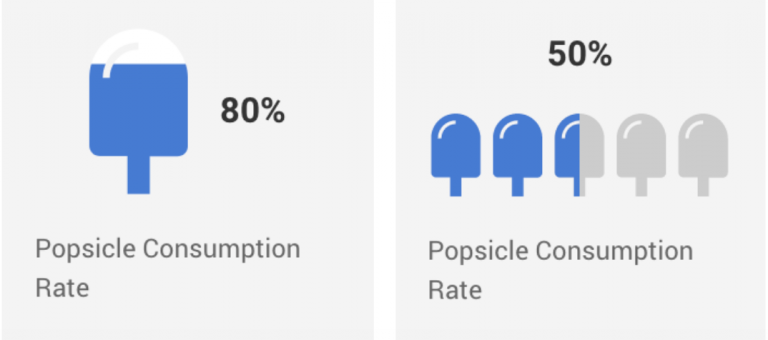
Pictograms express information, ideas, or messages through images, signs, or symbols. Also, they can help simplify complicated concepts.
6. Be thoughtful of your color scheme.
Your choice of colors can have an impact on your audience’s mood and perception of your presentation. It may not be evident at first glance, but your presentation colors can draw a particular set of feelings from your audience. Orange looks more carefree than beige, right?
Here are some quick tips to help you pick the right color combination for your presentation:
- Choose a color scheme that matches your presentation’s theme. For example, if you’re about to present a serious topic, consider somber, dignified colors like white, black, or brown. But if you want your presentation to be more upbeat, use lighter hues like yellow and orange.
- Use your brand colors to raise brand awareness and recognition.
- Stick to 2-3 colors. Joint research by Adobe and the University of Toronto revealed that most people prefer a combination of 2-3 colors. A good rule of thumb is not to use more than four colors. When using more than 3-4 colors, go for shades, tones, and tints of your original colors like the example below.
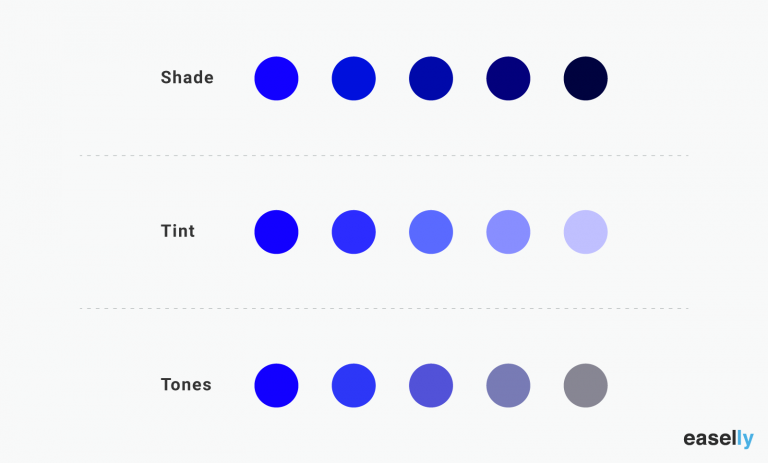
7. Focus your audience’s attention using data visualization.
Presenting statistics and percentages in writing can be a challenge to use in your presentation. For this reason, consider data visualization.
For example, graphs and charts are often used to highlight comparisons in data. You can also use them to inform your audience of a specific data point.
It’s worth noting that a poorly-designed graph or chart could ruin your presentation if proven false or shabbily done. Make sure that your data are correct, and your diagrams or charts are correctly labeled. Don’t just use pie charts because they look hip and smart. You have to learn how to choose the right chart or graph to visualize your data.
8. Use presentation templates.
Templates often take a bad rap because they’re perceived as limiting, sapping one of creative freedom. However, templates shouldn’t be perceived this way.
Think of templates as frameworks or a set of building blocks that you can tinker with as you create your presentation. Without a templated structure, you’ll likely waste a lot of time and resources making your presentation from scratch.
For example, use infographic templates as a way to make your presentation more engaging (minus the time-consuming task of making a presentation from scratch. The process infographic template below is perfect if you’re explaining a process in one of your presentations.
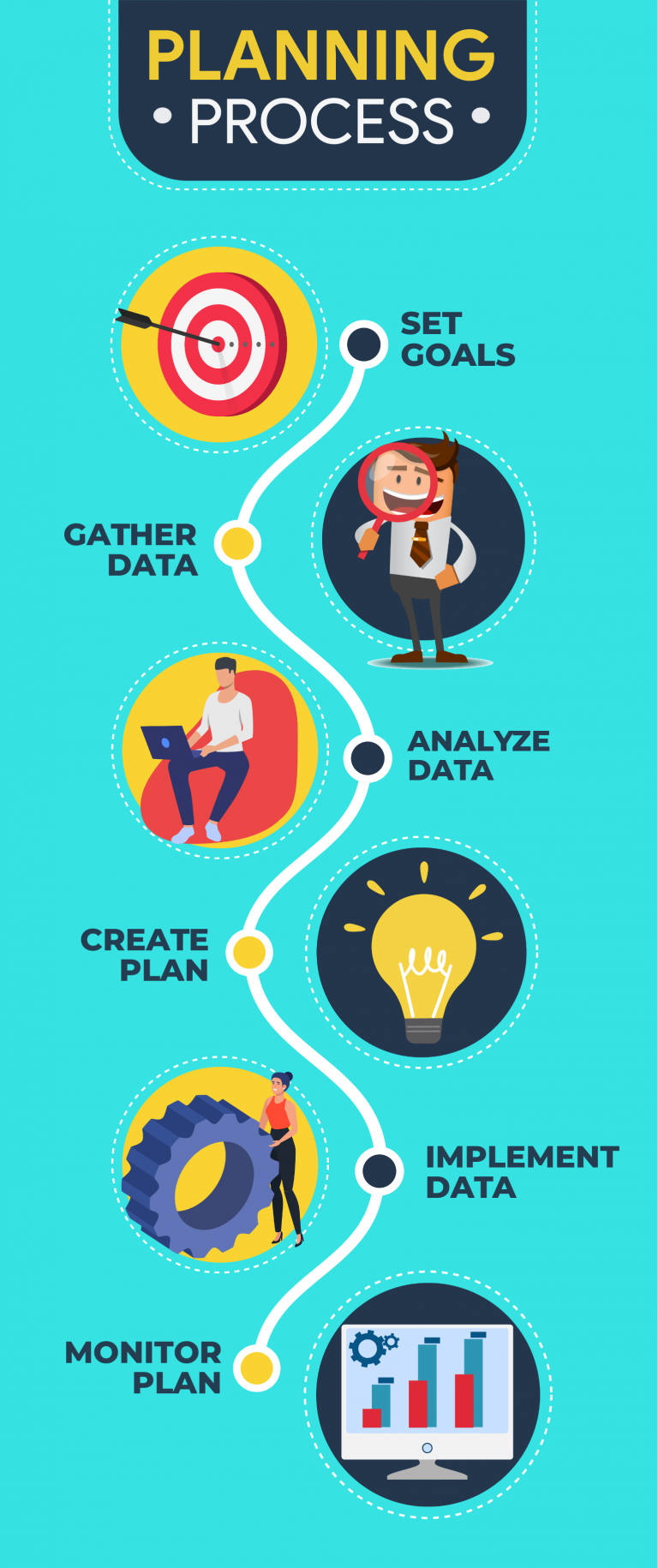
9. Try the duotone effect in your presentations.
The duotone effect is the use of two contrasting colors to create dramatic, visually pleasing results. Thus the name duotone.
This design style is gaining popularity with designers and non-designers alike. Learn more from this quick duotone tutorial via Adobe .
10. Show, don’t tell.
Stories are a powerful medium to get your audience to sit up and listen to you. For this reason, aim to “show” rather than “tell” your audience about a topic, insight, or idea.
For example, don’t just state facts or figures about the dangers of not investing in their retirement. Instead, share the story of someone you know who failed to plan for their retirement, nudging your audience towards making their own conclusions or insights.
Don’t bombard your audience with too much information all at once. Avoid jargon or complex concepts without sharing a story that’ll resonate with them. With compelling storytelling, you can create anticipation and then slowly build up to your key points.
11. Incorporate infographics into your presentation.
Infographics are valuable presentation tools because they combine visuals and text. As a result, you can communicate with impact.
Furthermore, infographics make your presentation more memorable. How?
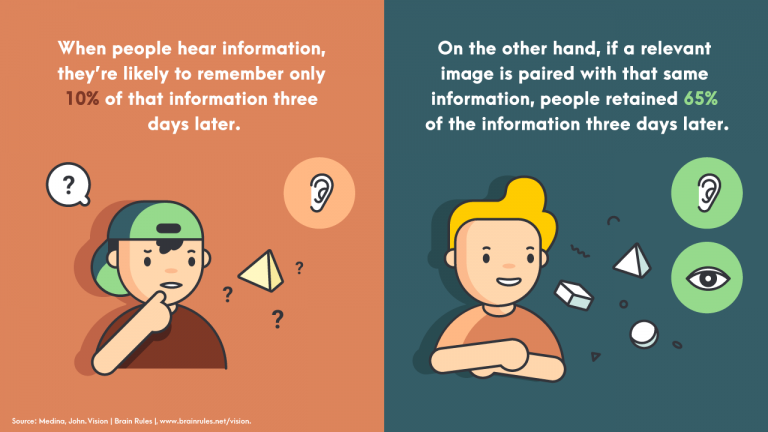
A relevant image paired with informative text helps people retain 65 percent of the information three days later — a stark contrast to presenting text-only content where someone’s likely to remember only 10 percent of the information.
Here are a few guides and tutorials when creating infographics for your next presentation:
- Guide to Making Infographics from Scratch (guide)
- 5 Ways to Use Call to Action in Your Infographic to Boost Audience Engagement (video)
- How to Write Sharp, Compelling Infographic Copy (guide)
Easelly Pro Tip: Divide long infographics into smaller segments. Add an infographic section for each presentation slide. If you’d like to raise the bar further for your presentation, try animated infographics to make your slides come to life.
12. Avoid using bullet points.
Bullet points are great tools to emphasize tips, features, or steps in lists. However, it’s best to avoid them in presentations because they don’t help your audience retain information.
Research even supports this recommendation. In 2014, the International Journal of Business Communication published the results of their research — The Use of Visualization in the Communication of Business Strategies: An Experimental Evaluation .
The researchers wanted to learn whether the use of visuals is superior to text (a bulleted list to be specific) in communicating the strategy of the financial services branch of an international car manufacturer.
The researchers concluded the following:
“Subjects who were exposed to a graphic representation of the strategy paid significantly more attention to, agreed more with, and better recalled the strategy than did subjects who saw a (textually identical) bulleted list version.”
Instead of using bullet points, consider using icons or visuals.
Take a look at the example below. Which do you think will likely get the audience’s attention and be more memorable after the presentation?
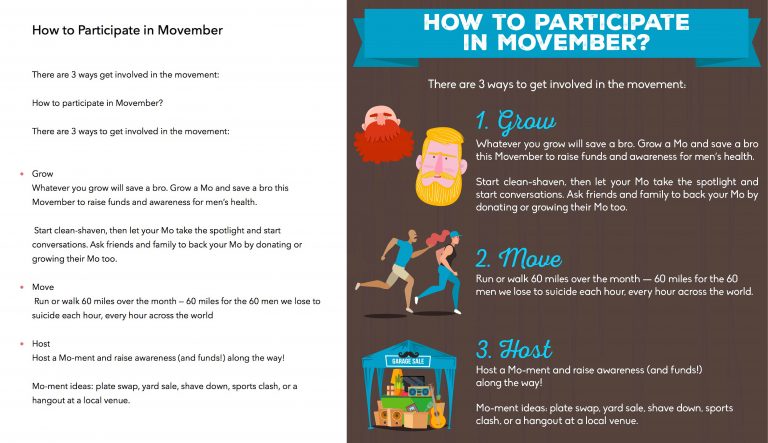
13. Choose fonts that are easier to read.
The quality of your font could affect your audience’s reaction to your presentation. Don’t just use the first standard font that pops up in your presentation editor.
Your font should match the mood and intent of your presentation. If you want your presentation to appear casual, choose a font that gives off a similar feeling.
14. Use contrast in your presentation.
Check for contrast between your texts and presentation background to ensure readability. Make it a point to distinguish one from the other.
It’s also worth noting that you are going to show your presentation to a group of people. Depending on the seating arrangement, viewers at the back may find it hard to read your presentation. Make sure that your fonts are of the appropriate size. That way, none of your audience members will have to struggle reading your slides.
15. Consider gifs and memes
Gifs and memes are popular media tools for a good reason. You could incorporate them into your presentation, and they could add a sense of humor to your topic or pitch.
When using gifs and memes, avoid those that could be misinterpreted as politically incorrect or culturally insensitive.
16. Create a consistent look and feel in your slides.
Choose a theme for your presentation templates, and stick with it ’til the end.
This doesn’t mean that you should be boring or dull with your presentation. You can add images and infographics, but there should be a sense of consistency in your slides.
Consistency leads to familiarity, which in turn encourages learning and engagement.
17. Ask intriguing questions.
Asking intriguing questions enables you to draw your audience’s attention and highlight key points at the same time.
For example, you are conducting a presentation on the Roman empire. You want to get your audience’s attention, so you raise questions such as what they know about the Roman empire, and how did the Roman empire impact modern society?
The audience may or may not get the right answers, but they will most likely try their best to answer your questions. The resulting exchange of ideas will make your presentation more spontaneous and engaging.
18. Limit to one visual per slide.
Using too many visuals at once will make your presentation appear cluttered. Limit to one visual per slide to help your audience engage more with your text and information.
19. Embrace white space.
White space , also known as negative space, is the space between the lines of texts and visuals in your presentation. It doesn’t have to be white as it can also take the color of your presentation’s background. Think of white space as “empty space”.
It helps improves readability and ensures that your graphics and texts are clear and legible in your presentation.
20. End your presentation with an excellent call-to-action.
Call-to-action statements are an integral part of any presentation. They compel your audience to take action, and it makes your presentation more interactive.
Here’s a short video explaining how to use call-to-action in infographics (the same principles apply for presentations!):
Say you’re designing a presentation for a new gym you’re managing. You want people to try out the gym and the services you offer. You could incorporate the call to action at the end of your presentation.
“See you at the gym next week?” or “Level up in the New Year by signing up for our free gym membership for a month!” are good call-to-action statements that you can use.
Ready to start creating your presentation?
We’ve got your back if you need help with your visuals and infographics for your next presentation.
Use our simple infographic maker tool or hire one of our infographic design pros for custom infographics and animated infographics .
Here’s to a stellar presentation – we’re rooting for you!
More to learn from the blog…
What is information design and why it matters now more than ever.
Have you ever found yourself squinting hard while reading too small instructions in your coffee maker manual? Or have you had problems fill...
10 Amazing Infographic Templates You Can Use Today
Are you looking for free infographic templates that you can edit and download for your next powerpoint presentation, school project, or bus...
20 Process Infographic Templates to Help You Save Time
Most of the time, detailed descriptions are adequate. But when you need to communicate ideas and information quickly, process infograph...
3 Ways to Keep Your Audience Focused During a Presentation
by Matt Abrahams

Summary .
Attention is our most precious commodity. In today’s fast-paced world of always-on digital devices and round-the-clock media cycles, getting our audience’s attention is critical to our communication success. With so many distractions vying for our time, we must actively seek and gain our audience’s attention first.
Partner Center
Home Blog Presentation Ideas The Power of Audience Engagement: Strategies and Examples
The Power of Audience Engagement: Strategies and Examples
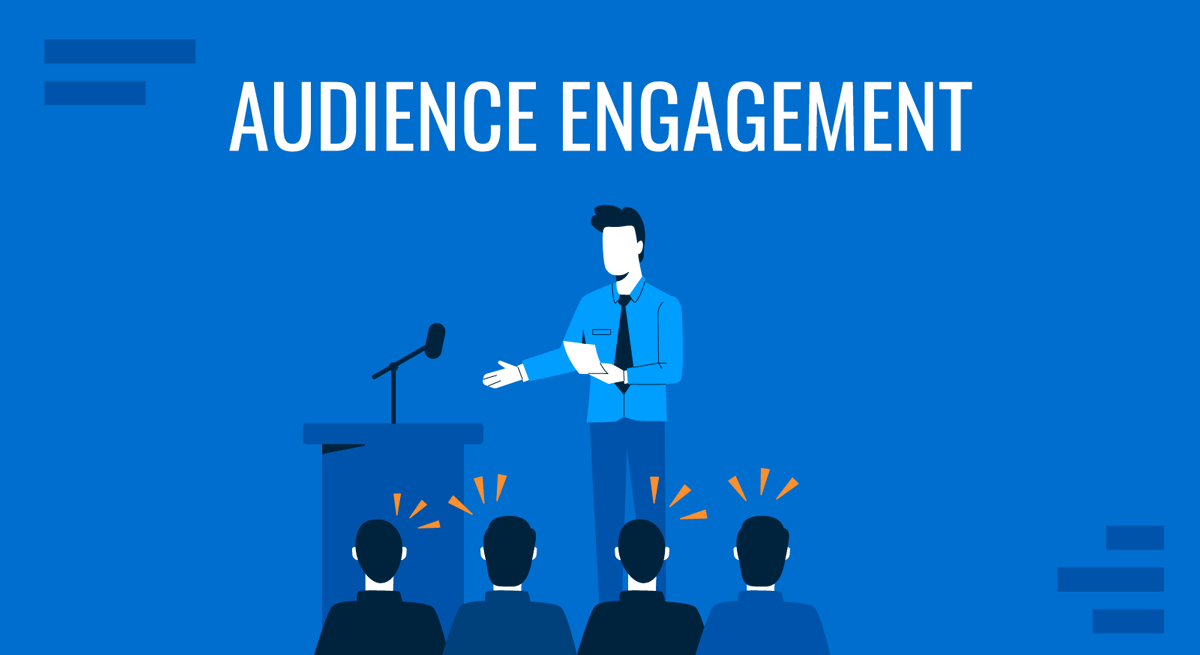
Engaging your audience is vital to effective presentations, business interactions, and media communication. It’s a powerful tool that fosters connection, enhances knowledge retention, and drives action. Research conducted on audience engagement informs us that physiological factors like cardiac synchrony can be appreciated when the spectators feel a deep emotional connection to the event they are attending.
This article explores the importance of audience engagement in presentations, offering practical strategies, rules, and tools to captivate your audience with real-life examples and methods to measure engagement.
Table of Contents
What is Audience Engagement?
Strategies for audience engagement in presentations, rules of audience engagement, real-life examples of audience engagement, tools for boosting audience engagement in presentations.
We can define audience engagement as the degree of interaction and involvement of individuals in a particular activity or event. It’s not merely about having an audience but cultivating a dynamic relationship with them. This engagement is gauged by the level of attention, interest, and emotional connection an audience has towards the content they are consuming.
Audience engagement is not a one-size-fits-all concept. It varies based on the nature of the audience, the platform used, and the goals of the engagement. However, at its core, it’s about creating a two-way communication that values the audience’s input and encourages them to interact, participate, and connect – a point of particular interest in motivational presentations. This engagement is beneficial and essential in today’s digital age, where attention is scarce . A high level of audience engagement signifies that your message resonates with your audience and that they are invested in your content or cause.
The Role of Audience Engagement in Business, Education, and Social Media
Audience engagement is pivotal in various sectors, including business, education, and social media. For business professionals, it translates as the cornerstone of customer relationship management. Engaging customers is not just about making sales; it’s about building relationships, cultivating loyalty, and creating brand advocates. Businesses prioritizing audience engagement tailoring their advertising efforts to attend to the customer’s driving factors , often enjoy increased customer retention rates and higher profits.
Engaging the audience in business environments also involves high-level meetings between organizations and potential investors, as the closer the speaker connects with the audience, the better impact tools like a business pitch may have.
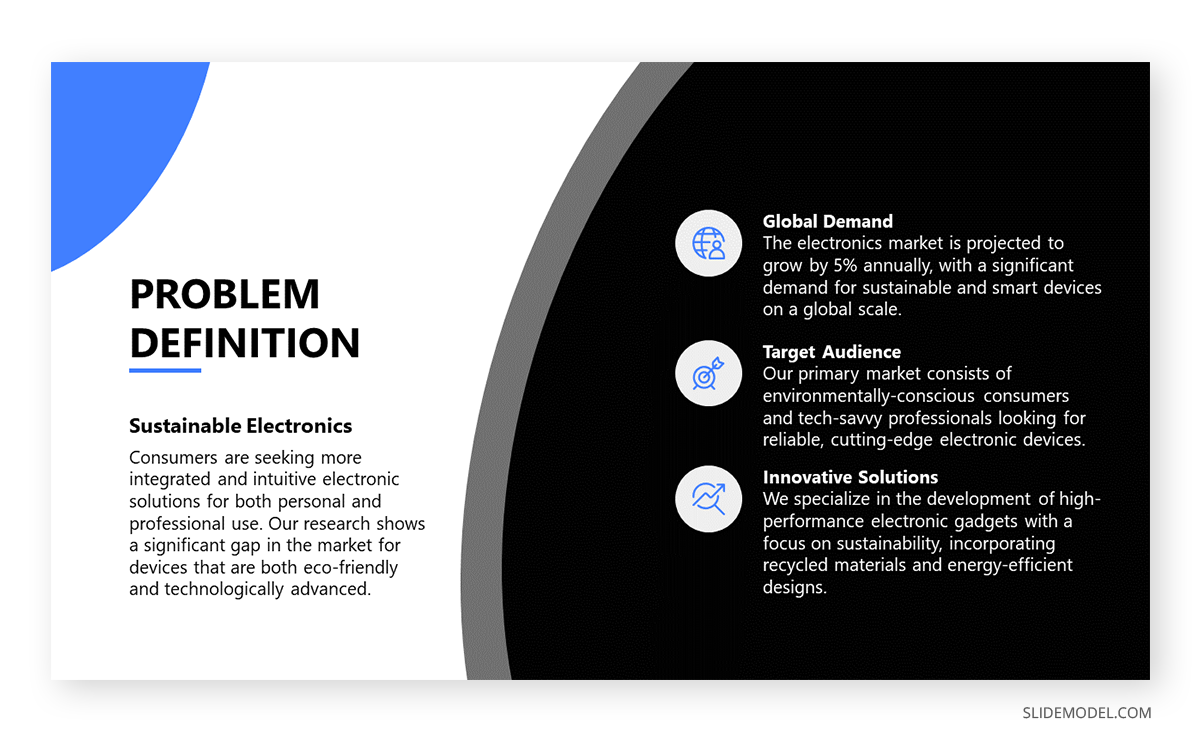
Moving on to academics, educators strive to captivate their students’ attention, stimulate their curiosity, and encourage active participation in the learning process. Engaging students leads to improved comprehension , better retention of information, and a more enjoyable learning experience. It’s not just about imparting knowledge; it’s about inspiring a love for learning and nurturing critical thinking skills.
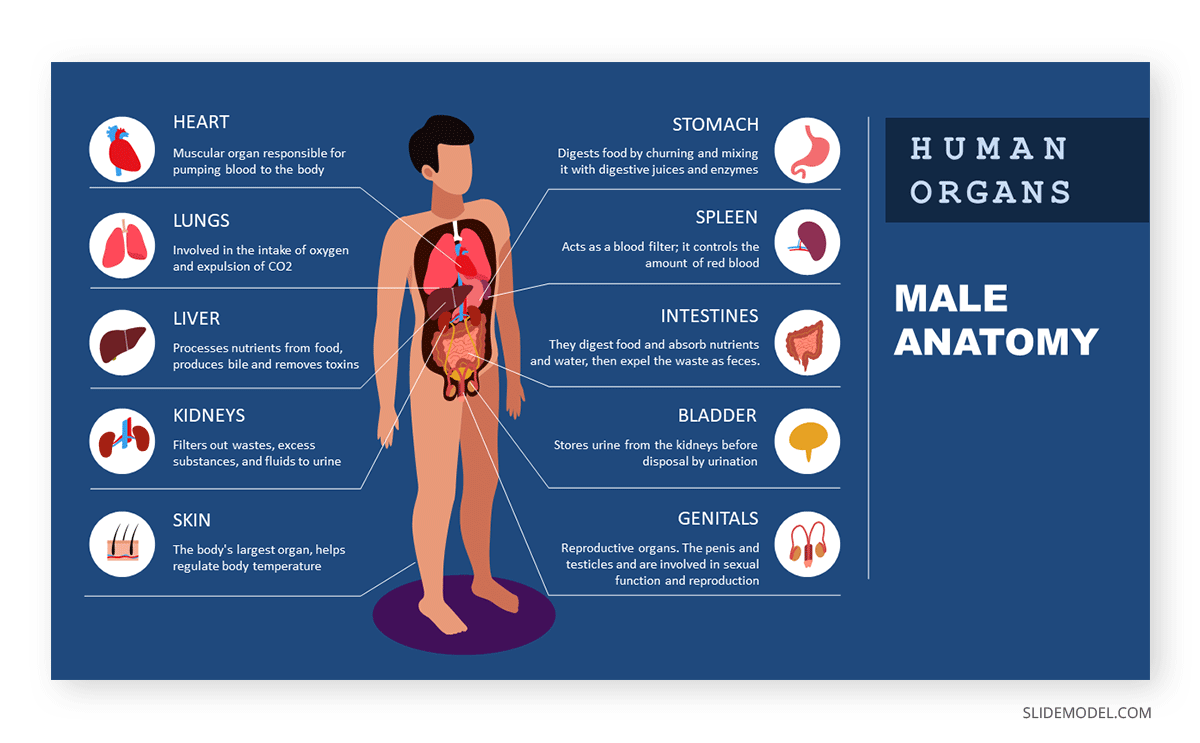
We can guarantee that audience engagement is the key to visibility and influence on social media platforms, as experience does tell. The algorithms of most social media platforms prioritize content with high engagement rates, making it more likely to appear in users’ feeds. Therefore, influencers, brands, and individuals wishing to maximize their reach must create content encouraging likes, comments, shares, and other forms of engagement.
First Impressions and Relevance
The relevance of your content to your audience’s interests or needs determines their level of engagement. To achieve this, understand your audience’s demographics and preferences, then tailor your content to match these. This strategy not only grabs attention but also fosters a lasting connection.
Presenters should research techniques for how to start a presentation to ensure a great first impression with the audience. Our expertise tells us that over 60% of the success rate of the presentation is granted during that first introductory minute, so don’t neglect the first opportunity to connect with your attendees.
Utilizing Practical Information
To engage your audience effectively, provide practical, actionable information. This boosts your credibility and empowers your audience, making them more likely to interact and relate with your content. Remember, the more value you offer, the greater the engagement rate you’ll receive.
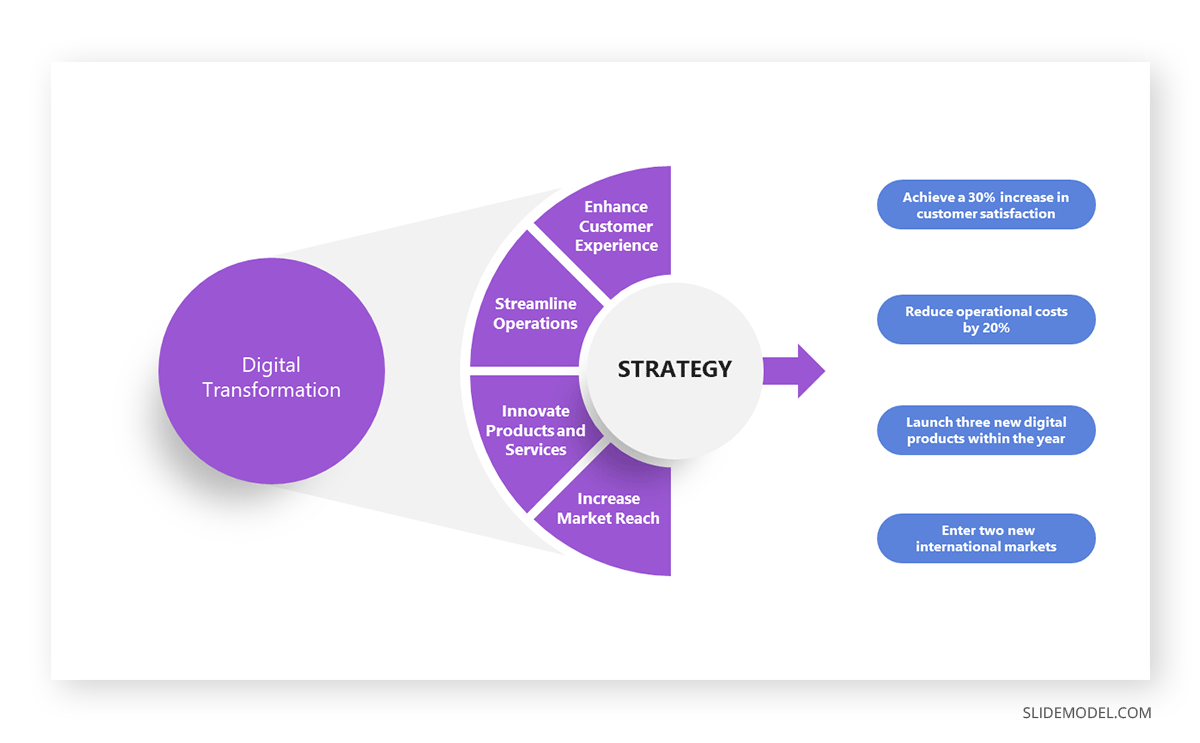
Applying Tools to Raise the Impact of Your Speech
To amplify your speech’s impact, leverage tools like visual aids, storytelling , and rhetorical devices. Visual aids such as infographics can simplify complex ideas , while storytelling can evoke emotions and make your message more memorable. Rhetorical devices like repetition can emphasize key points, ensuring they resonate with your audience.
The Power of a Familiar Environment
To enhance presentation performance, create a familiar environment. Use common language, relatable examples, and shared experiences to establish comfort. This strategy nourishes connection, encourages participation, and promotes audience engagement, thereby boosting the impact of your presentation.
Understanding Audience Needs
There are techniques you can apply prior to your presentation to ensure your content is tailored for the target audience. Conduct demographic research to understand their age, gender, occupation, and interests. Next, engage with them through surveys (via email if they signed up for the event online) or social media to grasp their desires and pain points.
Analyzing their behavior, such as purchasing habits, can also provide valuable information. Consider their cultural and social context to understand their perspectives. Remember always to be open to feedback: this will not only show your audience that you value their opinion but also help you tailor your approach to meet their needs.
Maintaining Authenticity and Consistency
Presenters are often blamed for trying to emulate successful examples rather than using their own voices. First, be genuine. Authenticity resonates with audiences, making your message more compelling. Avoid pretense and remain true to your character, values, and beliefs. Second, maintain consistency. Your message should be coherent and consistent throughout. This includes your speech, visuals, and body language (and yes, this can be pretty evident in your interest in the topic you present). Inconsistencies can confuse your audience and weaken your message.
Consistency also extends to your brand or personal image. Ensure that your presentation aligns with your established image. This will reinforce your credibility and build trust with your audience. Lastly, practice regularly to maintain a consistent pace and tone. This will help you avoid sudden changes in speech that can disrupt the flow of your presentation.
A compelling example of audience engagement in the IT sector is the transformation of Microsoft under the leadership of Satya Nadella . Before Nadella’s tenure, Microsoft was losing its grip on the market, with dwindling audience engagement. The company was perceived as outdated and unresponsive to customer needs. However, Nadella implemented strategies to reinvigorate the brand and boost audience engagement. He prioritized open communication, encouraging employees to listen to customer feedback and respond promptly. He also championed using social media platforms to interact with customers, providing quick solutions to their problems. This strategy increased audience engagement and improved the company’s reputation.
The impact of these strategies was measured using social media traffic and lead generation results. Microsoft saw a significant increase in followers on their social media platforms, and the lead generation rate also improved. The positive customer feedback and the measurable results motivated the team to continue pursuing excellence. They realized that their efforts were not in vain and that they were making a difference in the company’s performance. This example reveals the power of audience engagement in transforming a brand’s performance. It also highlights the importance of measuring results to motivate the team and ensure the effectiveness of the strategies implemented.
PowerPoint Presentation Templates by SlideModel
SlideModel PowerPoint and Google Slides templates are a game-changer for presenters, offering a comprehensive solution to design dilemmas. These templates simplify the process of creating visually appealing presentations, allowing presenters to focus on delivering their message effectively. The beauty of these templates lies in their complete editability. Presenters can customize each element to suit their unique needs, ensuring their presentation aligns with their brand and message. Moreover, SlideModel offers a vast selection of templates designed to cater to various business tools. Below you can find some examples of what these templates can do for you.
1. 5W1H Framework PowerPoint Diagram for Collective Thinking Audience Engagement
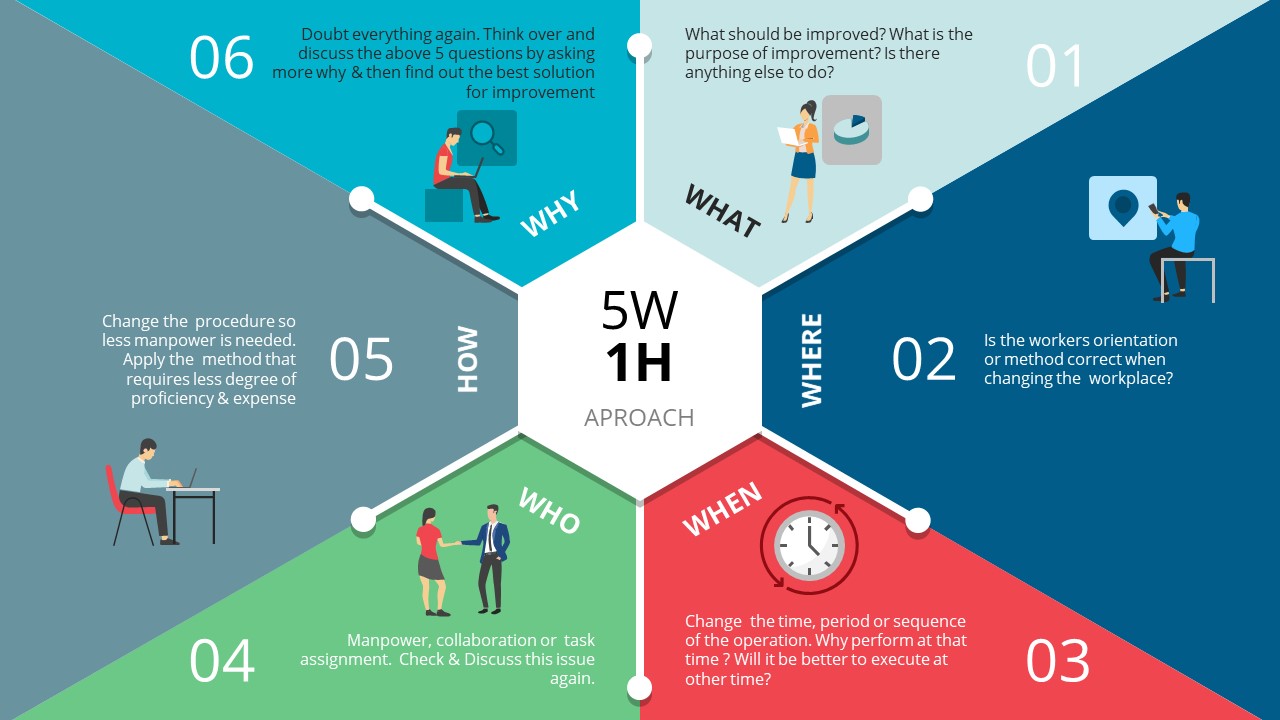
This framework counting with 5 why(s) and 1 how question is ideal to encourage team members to look for solutions as a group, as it requires a deep understanding of the causes behind a problem, plus an iterative technique of cause-and-effect analysis to reach for an answer.
Use This Template
2. Evaluation Scale of 1 to 10 Graphic for Engaged Presentations
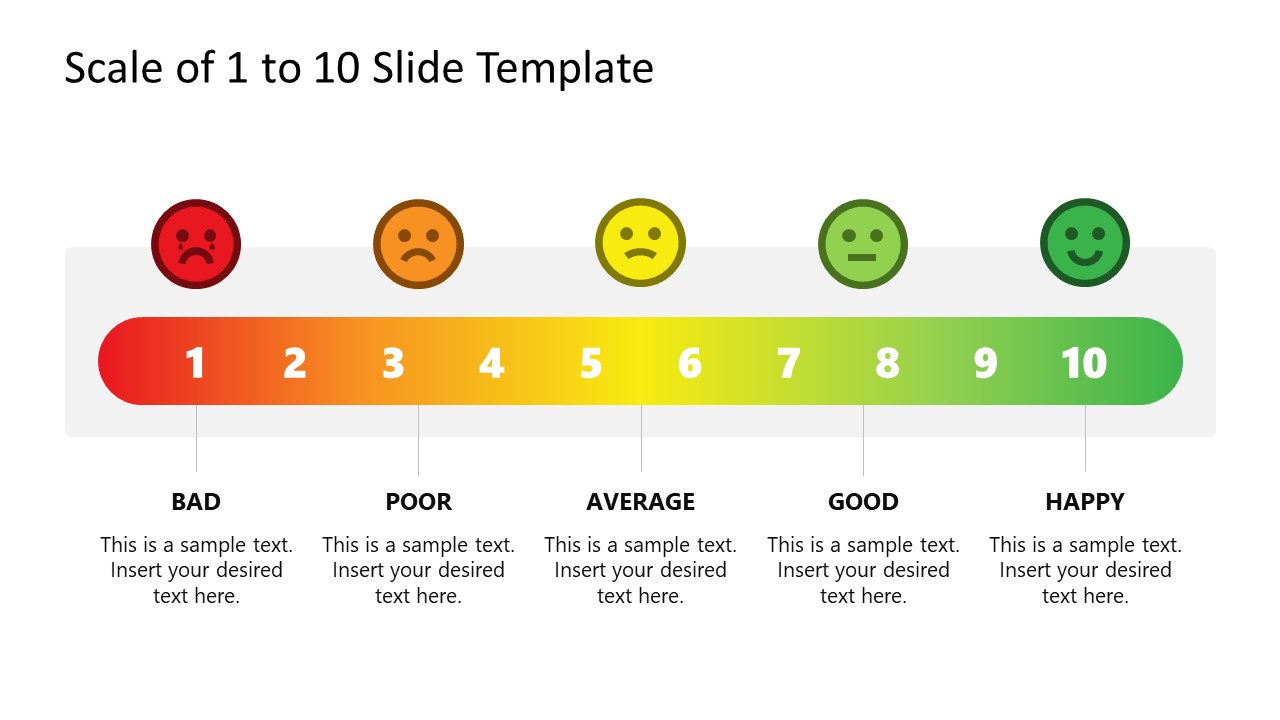
We can imagine meetings where we need to evaluate the conditions created after the impact of some of our choices. This scale of 1 to 10 PPT template helps teams to give a visible score and give the reasons behind their scoring to address the importance of certain topics. Ideal for in-team meetings where we have to determine the priorities for future work sessions.
3. Pros & Cons PowerPoint Template for Activities to Engage the Audience

Present the pros and cons of situations in a format filled with visual aids. By implementing the weighting scale metaphor, the audience can quickly understand why some decisions may have a bigger impact than others, or in case of products, why certain choices shape out the market performance of a product or service.
4. Team Introduction Template to Engage Listeners
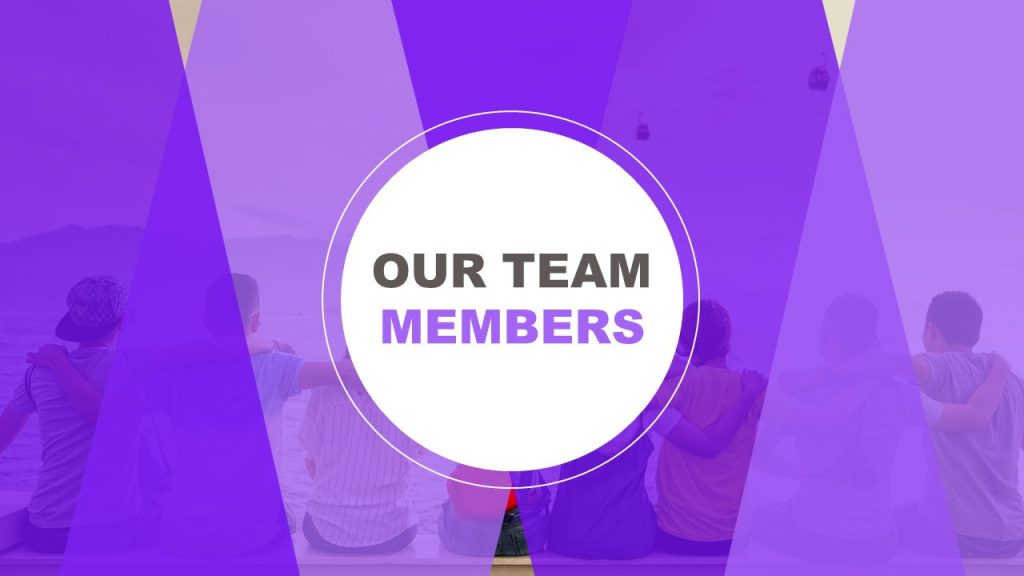
Who said that team presentation should be a boring part of the event? By using this striking colored presentation template for PowerPoint and Google Slides, each team member can introduce themselves in a blast, offering a clearer picture of their capabilities for the role they perform. Additionally, presenters can explain the relationships on a hierarchical level of each team member, how they contribute to the project, etc.
5. Customer Journey Storytelling Template for Audience Engagement
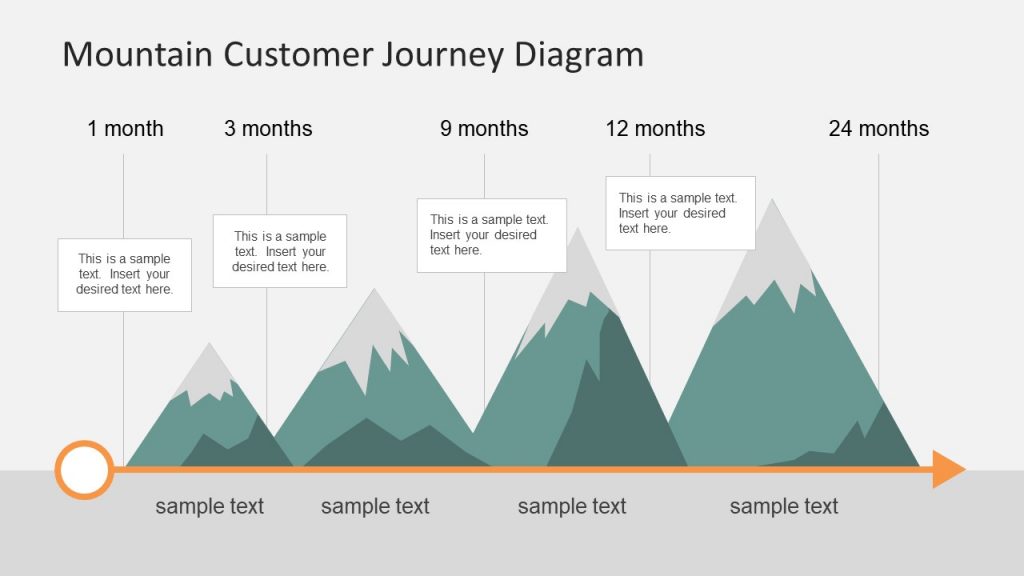
Take the typical approach to customer journey analysis and convert it into an engaging storytelling experience with this Mountain Customer Journey PowerPoint Diagram. It allows us to evaluate the progress, challenges, and changes to implement by taking the ideal customer persona or real-life data and evaluate in monthly periods.
Whether you’re presenting a SWOT analysis , a business plan , or a marketing strategy , there’s a template tailored to your needs. This variety enables presenters to choose a design that resonates with their topic, enhancing audience engagement. In a nutshell, SlideModel’s PowerPoint and Google Slides templates are indispensable tools for presenters, allowing presenters to use powerful graphics without requiring knowledge of graphic design.
The Power of Storytelling
Storytelling is a potent tool for audience engagement. It captivates listeners, stimulates their imagination, and fosters an emotional connection. By weaving a compelling narrative, you can effectively convey your message and make it memorable. Stories resonate with people personally, making them more receptive to your ideas. They also encourage active participation, as audiences often see themselves in the narratives, leading to a deeper understanding of your message. Whether you’re presenting a business proposal or educating a class, harness the power of storytelling to captivate your audience and leave a lasting impression.
Open-ended Questions
Open-ended questions stimulate thought, spark conversation, and encourage active participation. Unlike closed-ended questions, which limit responses to specific options, open-ended questions invite a wide range of answers, allowing audiences to express their thoughts, feelings, and ideas freely. This fosters a deeper connection and provides valuable insights into your audience’s perspectives, needs, and preferences. Whether you deliver a business presentation, teach a class, or host a live social media session, incorporating open-ended questions can significantly enhance your audience engagement strategy.
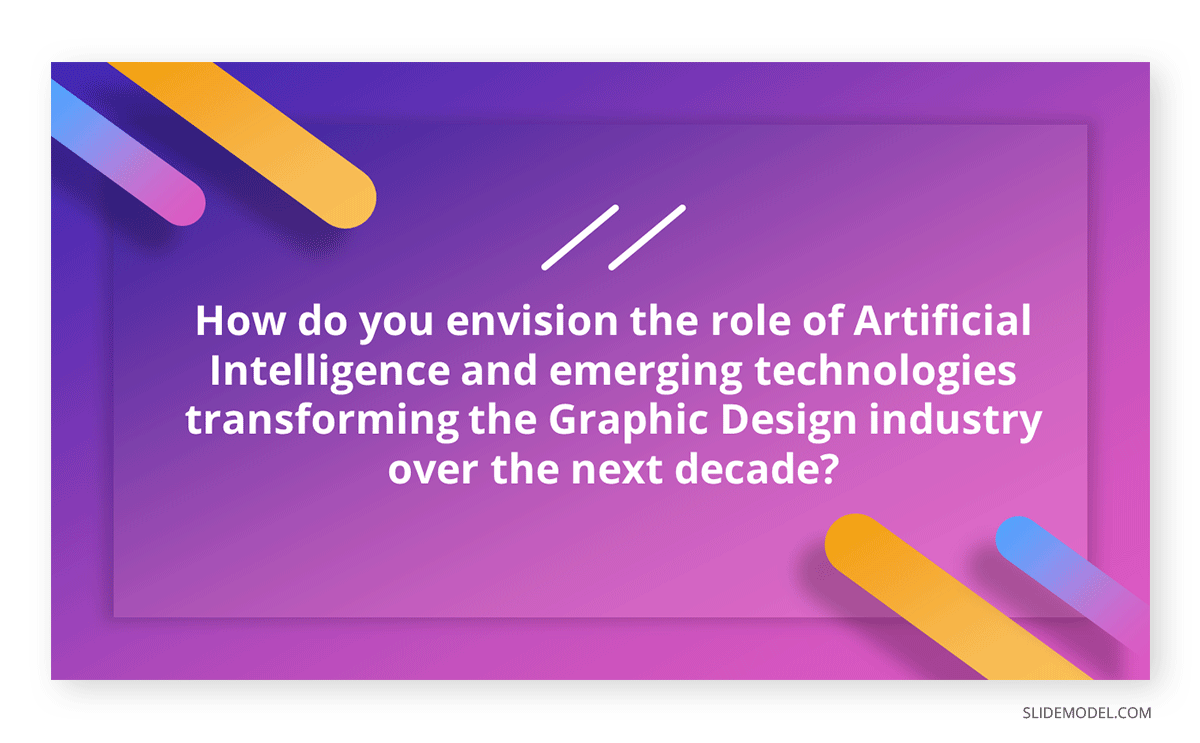
Polls and Surveys
These tools provide a platform for your audience to express their opinions, cultivating a sense of involvement and importance. They also offer valuable insights into your audience’s preferences, enabling you to tailor your content to their interests.
Real-time poll results can create a dynamic, interactive experience, keeping your audience engaged and eager for more. Remember, the key to successful audience engagement is making your audience feel heard and valued; polls and surveys are excellent tools.
Group Activities
Group activities promote collaboration and stimulate critical thinking. You can facilitate in-depth discussions, problem-solving tasks, or brainstorming sessions by dividing your audience into smaller groups. This not only keeps your audience actively involved but also encourages them to share their ideas and perspectives.
Furthermore, group activities can be designed to be entertaining, adding an element of enjoyment to the engagement process. Remember, an engaged audience is more likely to absorb and retain the information you present, making your event or presentation a resounding success.
Wrapping up, the power to captivate your audience lies in your hands. The techniques shared in this article are not just theories but practical strategies proven to boost audience engagement. From understanding your audience’s needs to maintaining authenticity, the impact of these strategies is undeniable. So, don’t just read and forget. Take action. Implement these strategies in your next presentation or event. Remember, the more engaged your audience, the more successful your message delivery. So, get started today and see the transformation in the lasting impact of your talk.
Like this article? Please share
Audience, Presentation Approaches Filed under Presentation Ideas
Related Articles
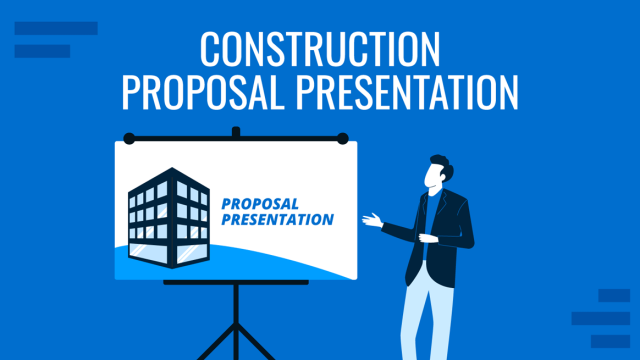
Filed under Business • October 31st, 2024
How to Create a Construction Proposal Presentation
Learn how to create winning construction proposal presentations with clear visuals, detailed information, and structured insights.
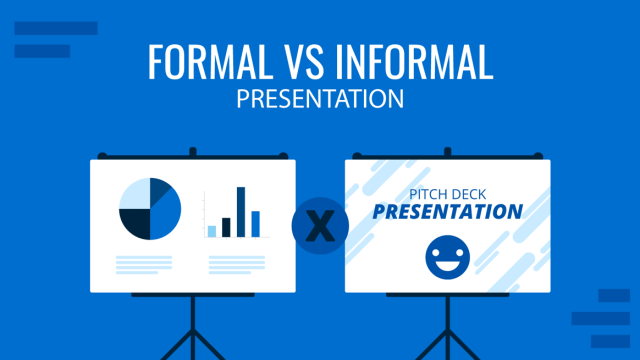
Filed under Presentation Ideas • October 23rd, 2024
Formal vs Informal Presentation: Understanding the Differences
Learn the differences between formal and informal presentations and how to transition smoothly. PPT templates and tips here!
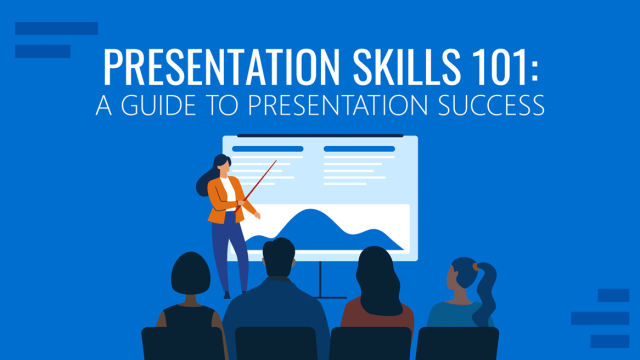
Filed under Education • October 21st, 2024
Presentation Skills 101: A Guide to Presentation Success
Building your presentation skills is a must-do in the career of any professional presenter. Cultivating some of these practices can guarantee an impact on the performance of your delivered message, so join us to discover how you can train for the required presentation skills.
Leave a Reply
We use essential cookies to make Venngage work. By clicking “Accept All Cookies”, you agree to the storing of cookies on your device to enhance site navigation, analyze site usage, and assist in our marketing efforts.
Manage Cookies
Cookies and similar technologies collect certain information about how you’re using our website. Some of them are essential, and without them you wouldn’t be able to use Venngage. But others are optional, and you get to choose whether we use them or not.
Strictly Necessary Cookies
These cookies are always on, as they’re essential for making Venngage work, and making it safe. Without these cookies, services you’ve asked for can’t be provided.
Show cookie providers
- Google Login
Functionality Cookies
These cookies help us provide enhanced functionality and personalisation, and remember your settings. They may be set by us or by third party providers.
Performance Cookies
These cookies help us analyze how many people are using Venngage, where they come from and how they're using it. If you opt out of these cookies, we can’t get feedback to make Venngage better for you and all our users.
- Google Analytics
Targeting Cookies
These cookies are set by our advertising partners to track your activity and show you relevant Venngage ads on other sites as you browse the internet.
- Google Tag Manager
- Infographics
- Daily Infographics
- Popular Templates
- Accessibility
- Graphic Design
- Graphs and Charts
- Data Visualization
- Human Resources
- Beginner Guides
Blog Marketing 15 Interactive Presentation Ideas to Elevate Engagement
15 Interactive Presentation Ideas to Elevate Engagement
Written by: Krystle Wong Aug 04, 2023

As attention spans continue to shrink, the challenge of engaging audiences in a short timeframe has never been more significant. Let’s face it — grabbing and keeping your audience’s attention can be quite the challenge, especially when time is ticking away. But fear not, I’ve got the perfect solution: interactive presentations!
Believe it or not, creating an interactive presentation is easier than you might think. In this guide, I’ll show you how to effortlessly turn ordinary slides into captivating experiences with 15 interactive presentation ideas that will leave your audience begging for more. From quirky polls and fun games to storytelling adventures and multimedia magic, these ideas will take your presentation game to the next level.
Venngage is a game-changer when it comes to empowering interactive presentations. With just a few clicks, users can customize their favorite presentation templates , add multimedia content and create immersive experiences that leave a lasting impact. Whether you’re a seasoned presenter or a newcomer, get started with Venngage to elevate your presentation game to new heights of engagement and creativity.
Click to jump ahead:
What is an interactive presentation?
15 ways to make a presentation interactive, 7 best interactive presentation software, what are some common mistakes to avoid when creating interactive presentations, interactive presentation faqs, how to create an interactive presentation with venngage.
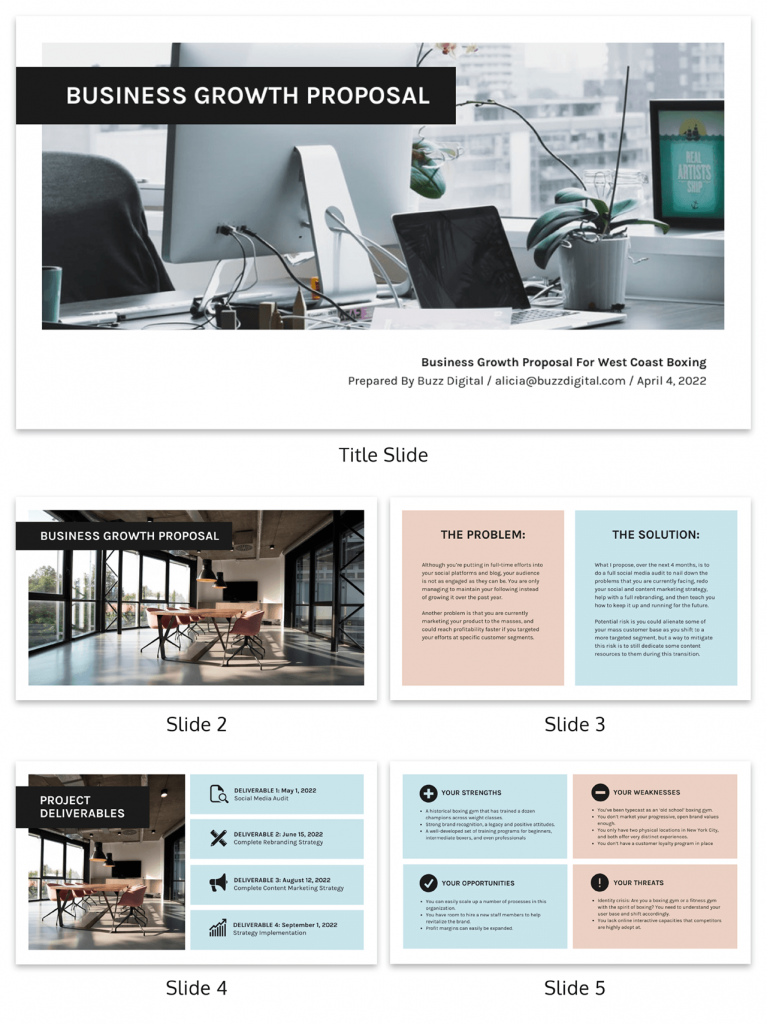
An interactive presentation is a dynamic and engaging communication format that involves active participation and collaboration between the presenter and the audience. Unlike traditional presentations where information is delivered in a one-way manner, interactive presentations invite the audience to interact, respond and contribute throughout the session.
Think of it as a two-way street where you and your audience have a friendly chat. It’s like playing a fun game where you ask questions, get live feedback and encourage people to share their thoughts.
To make a good presentation , you can utilize various tools and techniques such as clickable buttons, polls, quizzes, discussions and multimedia elements to transform your slides into an interactive presentation. Whether you’re presenting in-person or giving a virtual presentation — when people are actively participating, they’re more likely to remember the stuff you’re talking about.
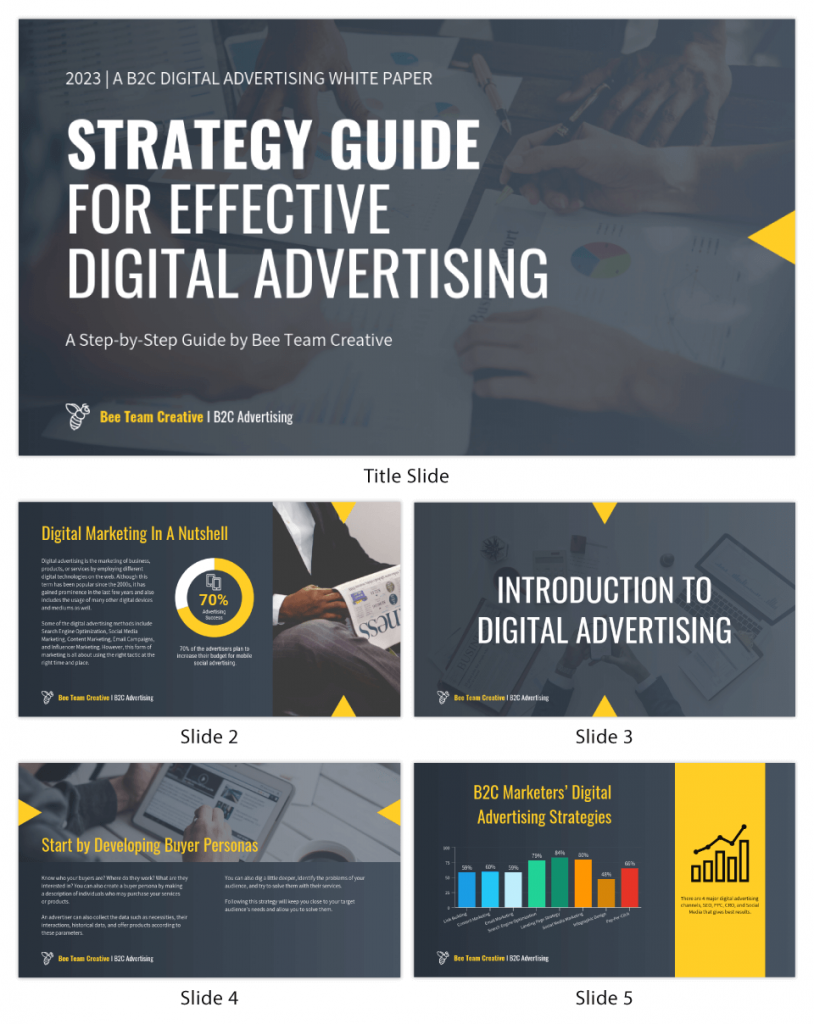
Interactive presentations leave a lasting impression on the audience. By encouraging active participation and feedback, interactive presentations facilitate better understanding and knowledge retention. Here are 15 innovative 5-minute interactive presentation ideas to captivate your audience from start to finish:
1. Ice-breaker questions
Start your presentation with intriguing and thought-provoking questions or a fun icebreaker game. These questions should be designed to pique the audience’s curiosity and encourage them to think about the topic you’ll be covering. By doing so, you create an immediate connection with your audience and set the stage for a more engaged and attentive audience.
For example, if you’re giving a business presentation about management and leadership training, you could ask audience questions such as “What’s the best business advice you’ve ever received, and how has it impacted your career?”
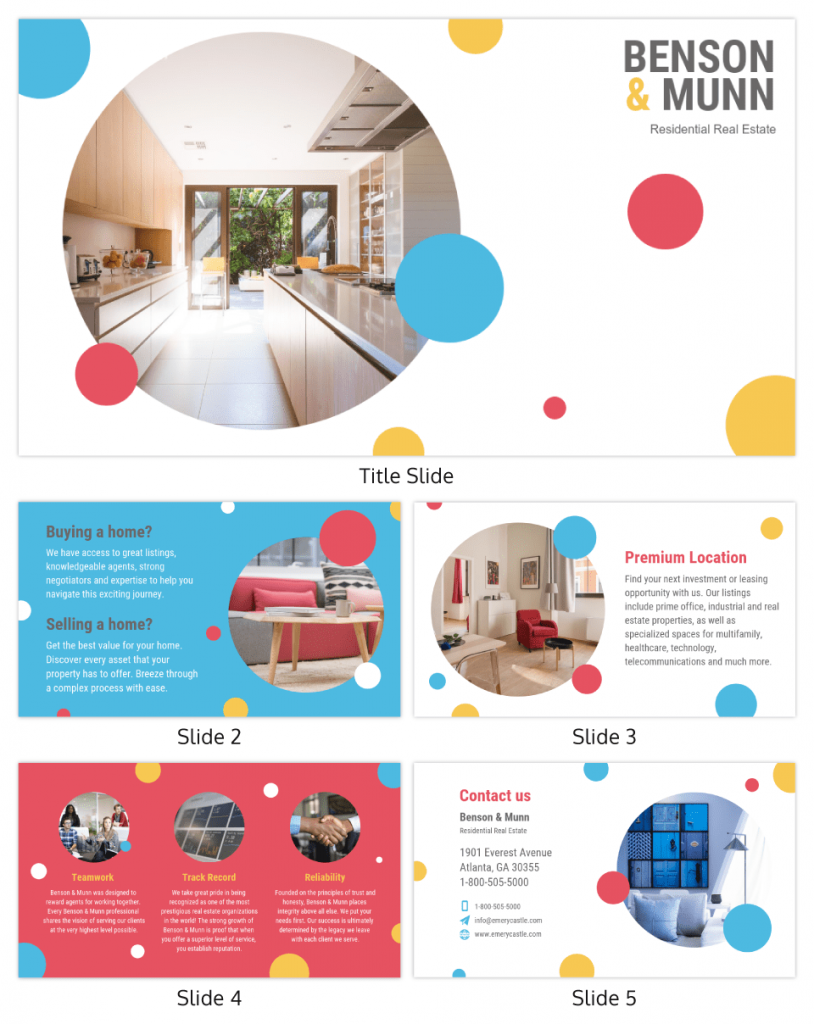
2. Live polling
Incorporate live polls during your presentation using audience response systems or polling apps . This allows you to collect real-time feedback, opinions and insights from active participants. Live polling encourages active participation and involvement, making your presentation feel like a collaborative and interactive experience.
3. Q&A sessions
Encourage the audience to ask questions throughout your presentation, especially for pitch deck presentations . Address these questions in real-time, which fosters a more interactive and dynamic atmosphere. This approach shows that you value the audience’s input and promotes a two-way communication flow.
4. Clickable buttons
Add clickable buttons to your slides, allowing the audience to navigate to specific sections or external resources at their own pace. For example, you could include links to your social media accounts or extra reading materials in your education presentation to give further information about the topic and get your students engaged.
By providing this autonomy, you empower the audience to explore areas of particular interest, creating a more personalized and engaging experience through your interactive slideshow.
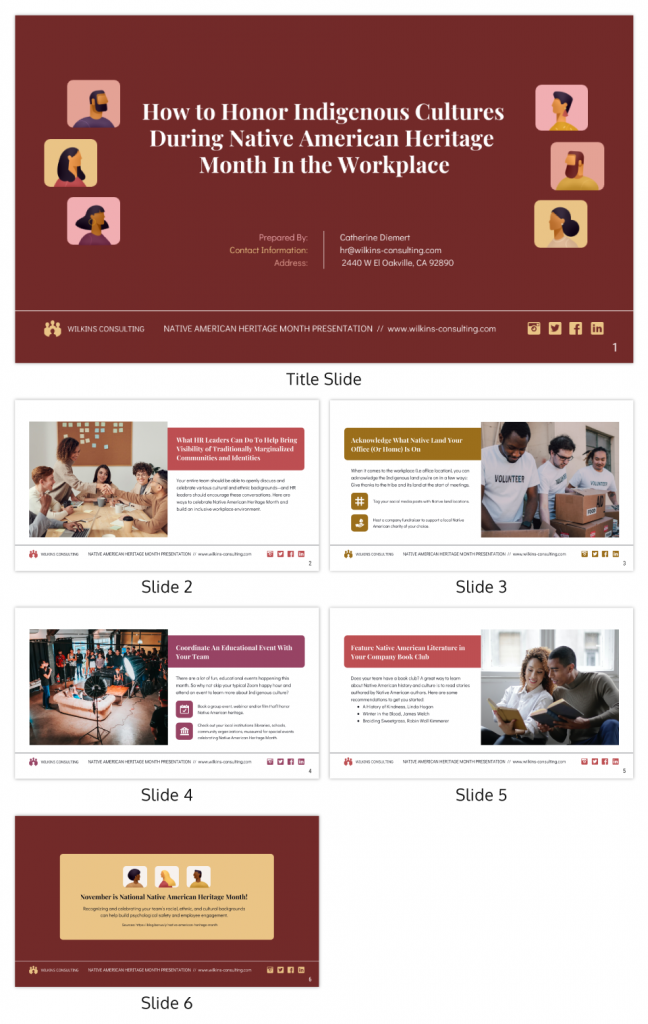
5. Storytelling
Incorporate anecdotes or personal stories related to your topic. Storytelling is a powerful way to emotionally connect with your audience, making your presentation more relatable and memorable. A little storytelling along with a set of creative slides draws the audience in and keeps them engaged as they follow the narrative.
6. Interactive charts and graphs
Use interactive charts and graphs that respond to user input to make your presentation interactive. For instance, allow the audience to click on data points to view more detailed information or to change the displayed data series. Creating charts with interactive visuals help the audience interact with the data, fostering better understanding and engagement.
7. Animated infographics
Add animations to your infographics, making them visually dynamic and progressive. Animated infographics reveal information gradually, keeping the audience curious and attentive. This transforms complex data into an easily digestible and engaging format.
Venngage’s extensive library of infographic templates is a powerful tool to visualize data and elevate the interactivity of your presentations. Personalizing the visuals ensures a cohesive and professional look throughout your interactive presentation. The templates are highly customizable, allowing you to adjust colors, fonts, and styles to match your presentation’s theme and branding.
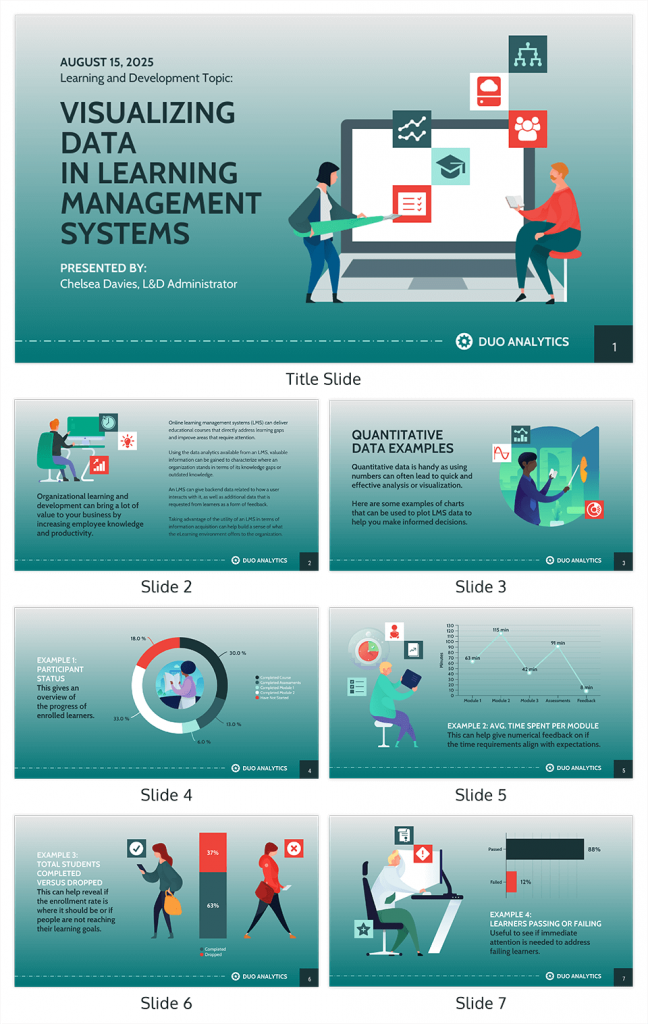
8. Gamification
Introduce an interactive quiz, puzzles, or challenges related to your presentation content. Gamification adds an element of fun and competition, motivating the audience to participate actively and boosting their learning experience. Here are some gaming presentation templates you could use.

9. Virtual reality (VR) or augmented reality (AR)
If applicable, leverage VR or AR technologies to provide immersive experiences. These interactive presentation tools transport the audience into a virtual or augmented environment, making your presentation more captivating and memorable.
10. Collaborative whiteboarding
Get your audience involved in your presentation by utilizing digital whiteboards or collaborative tools to brainstorm ideas collectively. This fosters teamwork and creativity, enabling the audience to actively contribute and feel a sense of involvement in the presentation.

11. Hyperlinked text
Keep the information in your slides minimal with a simple presentation and incorporate hyperlinks to direct viewers to relevant websites or blogs , resources, or additional information. This encourages self-exploration and gives the audience the opportunity to delve deeper into topics of interest.
12. Role-playing
Engage the audience in role-playing scenarios to explore different perspectives. Role-playing promotes active learning and helps the audience relate the content to real-life situations, enhancing their understanding and retention.
13. Embedded videos
Include video clips in your slides to provide visual explanations, demonstrations, or interviews. Videos add a dynamic element to your presentation, enriching the content and keeping the audience engaged. You can create these visual clips on a budget using a free screen recorder .

14. Audience-generated content
Encourage the audience to contribute ideas, stories or examples related to your professional presentation . Audience-generated content fosters a sense of ownership and involvement, making the presentation more interactive and personalized.
15. Slide transitions
Use slide transitions to create smooth animations between slides. Well-planned transitions maintain the audience’s interest and keep the presentation slides flowing seamlessly.
Interactive elements aside, enhance your presentation with these guides on how to summarize information for a captivating presentation and how to make a persuasive presentation to captivate your audience.
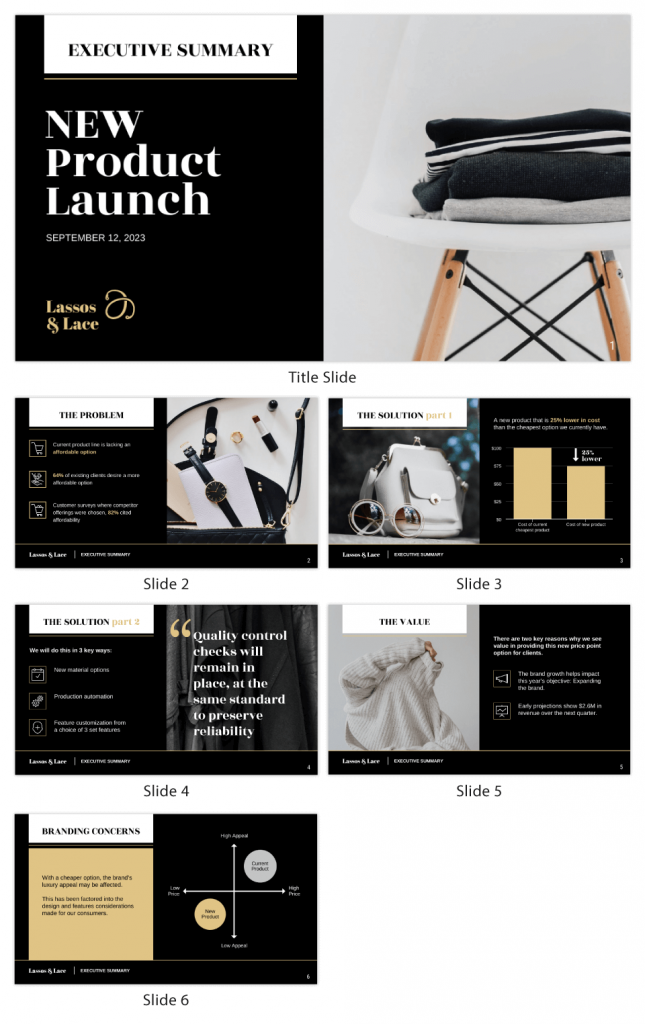
If you’re looking to create engaging and interactive presentation slides that captivate your audience, these presentation software options are sure to elevate your game:
Prezi is renowned for its dynamic and non-linear presentation style, enabling users to craft visually stunning and interactive presentations. With an array of templates and animation effects, Prezi enhances audience engagement, making your presentations more captivating and memorable.
2. Mentimeter
Mentimeter serves as an audience response system, empowering real-time interaction during presentations. Users can create interactive polls, quizzes, word clouds and more, allowing the audience to respond using their smartphones or other devices. This fosters active participation and provides valuable feedback instantly.
3. Google Slides
Google Slides is a free cloud-based presentation software that not only offers collaboration features but also enables real-time interactions. It includes add-ons and third-party integrations to further enhance interactivity, making it an excellent choice for collaborative and engaging presentations.
4. Microsoft PowerPoint
PowerPoint, a classic presentation software, has evolved to incorporate more interactive features like live captions, real-time collaboration and interactive elements such as quizzes and forms. With its familiar interface and versatile functionalities, PowerPoint remains a reliable choice for interactive presentations.
5. Prezentor
Prezentor caters to sales-oriented presentations focusing on interactive storytelling and data-driven content. It offers analytics to track audience engagement and behavior during presentations, allowing you to fine-tune your approach and keep your audience hooked.
6. Opinion Stage
Opinion Stage is a visual and interactive data collection tool designed to engage and excite audiences whether sitting in a lecture hall, participating in a live Zoom, or watching an on-demand webinar. The Opinion Stage tools are simple and intuitive, making it easy to create attention-grabbing quizzes, surveys, and polls in minutes. A great way to spice up any presentation, encourage audience participation, and collect authentic feedback.
7 . Venngage
Venngage stands out as a versatile design tool that facilitates the creation of interactive infographics, data visualizations and presentations with ease. Offering various interactive elements and animations, Venngage empowers you to craft visually appealing and engaging presentations effortlessly.
With these interactive presentation software options at your disposal, you can unleash your creativity and deliver presentations that leave a lasting impact on your audience. So, go ahead and make your presentations interactive, captivating and memorable!
For more presentation software options, check out this blog on the 12 best presentation software for 2023.
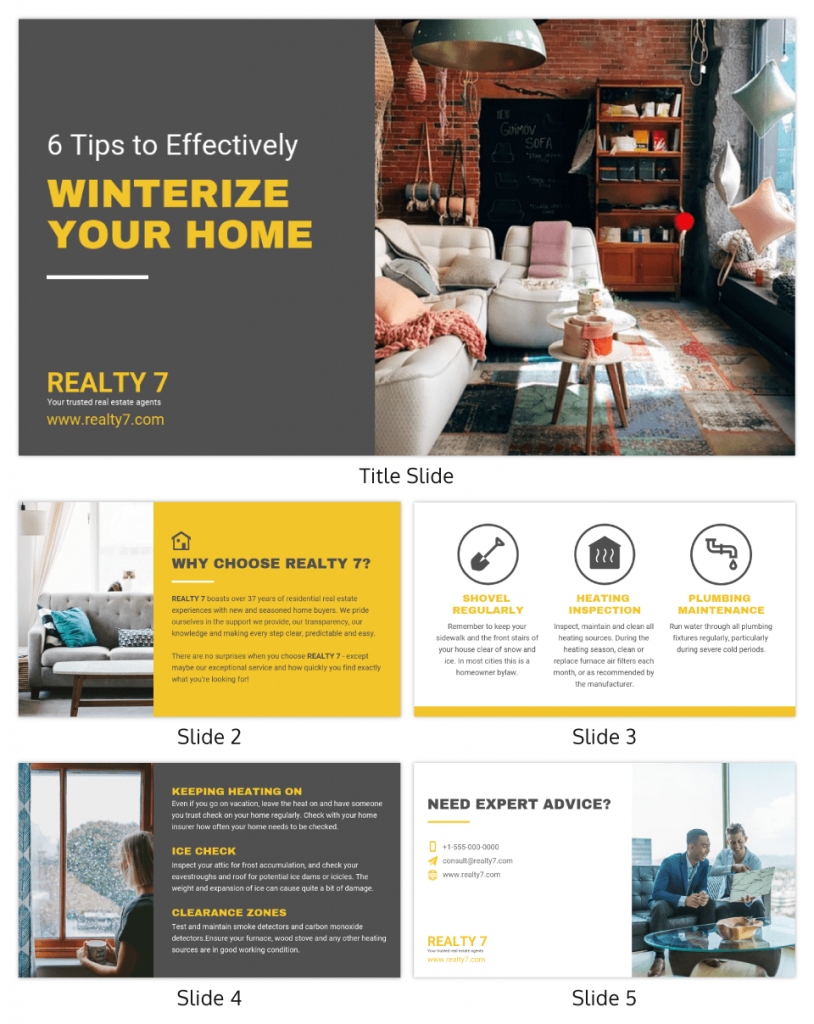
Creating interactive presentations can be a game-changer for engaging your audience and enhancing your presentation skills, but steering clear of common pitfalls is essential. Here are some key mistakes to avoid when crafting your interactive presentations:
1. Overloading with interactivity
While interactivity is fantastic, bombarding your audience with too many interactive elements can backfire. Strive for a balanced approach that enhances engagement without overwhelming your listeners.
2. Ignoring audience relevance
Failing to tailor interactive elements to your audience’s interests and preferences can lead to disconnection. Make sure your interactions resonate with your specific audience for a more meaningful experience.
3. Not testing interactive elements
Skipping thorough testing of interactive features before showtime can spell disaster. Avoid technical glitches by diligently testing all interactive components in advance.
4. Poor timing and pace
Timing is everything, especially with interactive activities. Ensure seamless integration by planning your key points and the timing of your interactive elements carefully.
5. Lack of clear purpose
Every interactive element should serve a purpose and contribute to your presentation’s objectives. Don’t add interactions just for the sake of it — ensure they add value and align with your message.
6. Failing to engage beyond interactivity
While interactive elements are powerful tools, remember that content is king. Combine your interactive features with compelling storytelling and valuable insights to create an immersive and impactful presentation.
Incorporating animated slides into your interactive presentations enhances the overall appeal and interaction, turning an ordinary presentation into an engaging experience. Try it out with one of our animated presentation templates to get started.
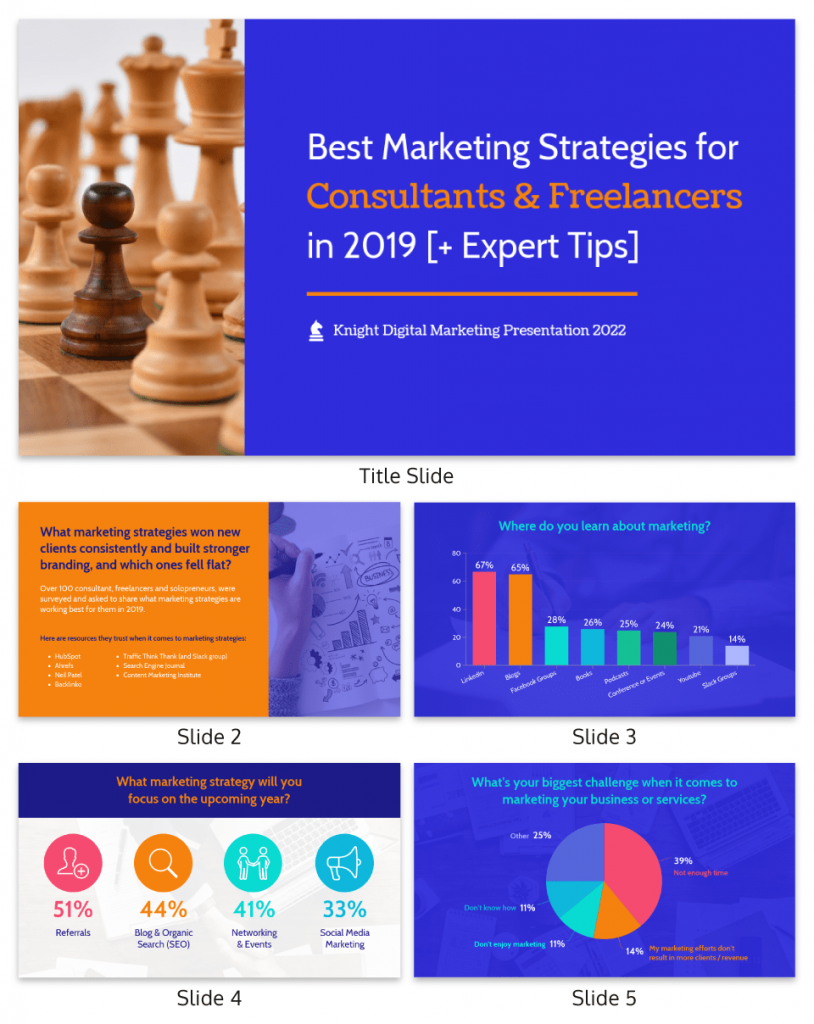
How do you start an interactive presentation?
Begin by grabbing the audience’s attention with an intriguing question or a surprising fact, setting the tone for a dynamic and engaging session.
Which type of presentation is the most interactive?
Workshops and seminars are often the most interactive types of presentations as they encourage active participation, discussions and hands-on activities.
How can interactive presentations enhance audience engagement?
Interactive presentations foster a two-way communication flow, involving the audience through polls, quizzes, discussions and multimedia elements, leading to increased interest, attentiveness and better retention of information.
What are some common interactive elements to include in a presentation?
Common interactive elements include clickable buttons, hyperlinked text, polls, quizzes, interactive charts, multimedia content and audience participation activities.
Can interactive presentations be used for educational purposes?
Absolutely! Interactive presentations are highly effective for educational purposes as they promote active learning, encourage critical thinking, and provide real-time feedback and knowledge exchange opportunities.
Need inspiration on how to give an engaging presentation ? Here are 120+ presentation ideas you could use.
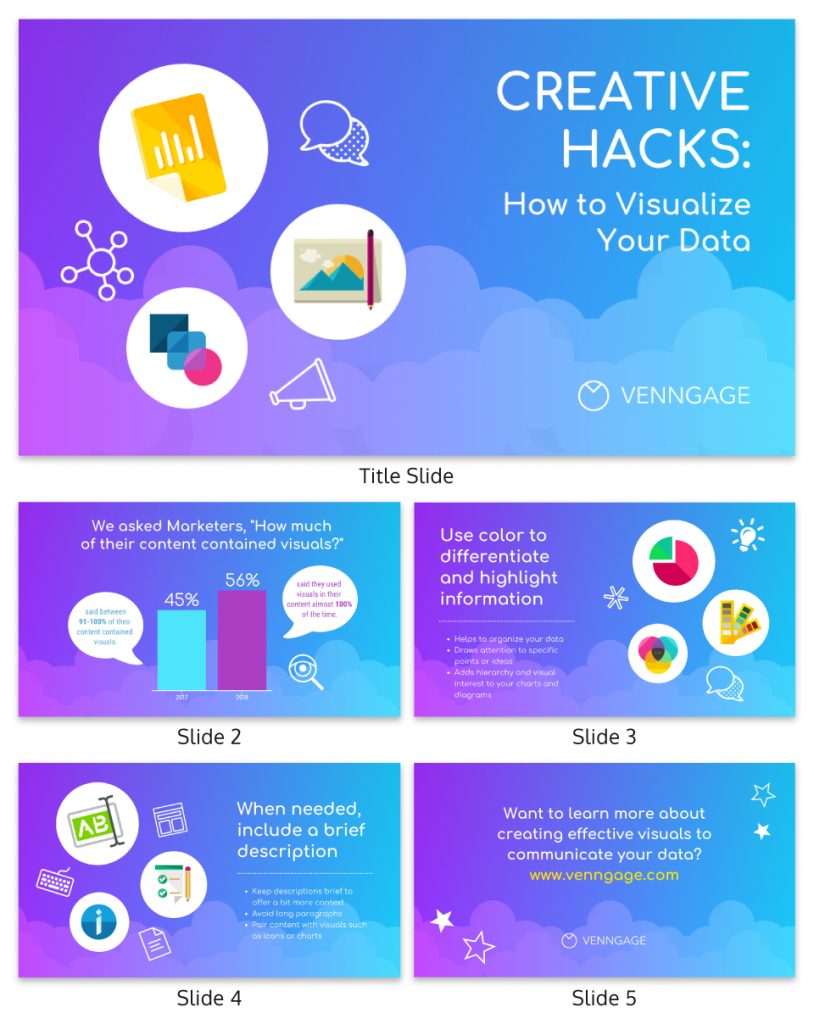
Venngage makes it easy for anyone to infuse interactivity into their presentations. From clickable buttons and hyperlinked text to interactive infographics and dynamic charts, Venngage offers a diverse range of interactive elements to captivate and engage the audience. Here’s how you can make your presentation more fun and interesting with Venngage:
- Sign up or log in to Venngage to access the platform.
- Choose a presentation template or start with a blank canvas to begin designing your interactive presentation.
- Add and edit slides in the Venngage editor to structure your presentation content effectively.
- Customize the design by selecting themes, fonts, colors and backgrounds to match your style and branding.
- Use interactive elements like buttons, links, pop-ups and hover effects to engage the audience during the presentation.
- Enhance engagement by incorporating interactive media such as videos and audio clips.
- Preview and test your entire presentation to ensure everything works smoothly before presenting it to your audience.
- Save your interactive presentation on Venngage and share it online or download it in various formats for presenting purposes.
Well, I hope these 15 5-minute interactive presentation examples can help unlock a new level of audience engagement for your next presentation. From fun quizzes and interactive storytelling to multimedia magic and gamified challenges, the possibilities are endless. So, don’t be afraid to experiment, tailor the ideas to suit your audience members and let your creativity shine.
That said, remember to strike a balance and keep the interactivity purposeful and relevant. Some common mistakes to avoid when creating interactive slides include overloading the presentation with too many interactive elements and failing to align the interactive elements with the overall presentation goals and content.
Got it? Great. Now let’s turn that boring presentation around!
Discover popular designs

Infographic maker

Brochure maker

White paper online

Newsletter creator

Flyer maker

Timeline maker

Letterhead maker

Mind map maker

Ebook maker

Improve your practice.
Enhance your soft skills with a range of award-winning courses.
18 Ways to Make Your Presentation More Interactive
November 10, 2017 - Dom Barnard
It can be difficult to hold your audience’s attention for the entire presentation. According to a Prezi study , half of the respondents said they did something other than listen during a co-worker’s presentation, including:
- Sending a text message (28%)
- Checking emails (27%)
- Falling asleep (17%)
An interactive presentation is much more likely to keep your audience’s attention and build rapport with them, and there are a few simple ways to achieve this, from live polling to asking questions throughout.
This article explores several different effective strategies for making the audience feel fully involved in your presentation and keeping your audience’s eyes away from their smartphones.
Why involve your audience?
Listening to a presentation for any length of time can be a difficult process. If you don’t involve the audience, they’ll start to play with their phones, talk to colleagues and generally lose track of what you are saying. Once this happens and you start seeing that the audience would rather be somewhere else, you’ll start feeling anxious and might try to speed up the presentation.

To engage a large audience fully, the presentation needs to be energetic, purposeful and staged, as if it is a direct conversation between both you and your audience. That way, they’ll absorb your ideas and insights and they’ll have learnt something in an enjoyable way.
1. Plan from the audience’s perspective
Before you start writing your presentation , think about these points:
- What are the most interesting parts in my topic?
- How much will the audience know about my topic? What level do I target it at?
- Which members of the audience will most likely be disinterested?
- How can I help them learn and understand my topic?
- What is the size of the audience?
You can do this by researching the event or conference, investigating other speakers at the event and even contacting the organisers to find out more about the demographic.
By asking these questions about your audience and identifying answers, you are starting to think about your audience’s interests and needs. Remember, the aim is to give the impression that your presentation has been planned according to your audience’s specific interests.
2. Use an easy-to-follow structure
When building your presentation, focus on giving it a structure which people can easily follow. Start by introducing the core concepts and goals, then elaborate on the various points in a bit more detail, draw logical conclusions and leave your audience with a clear takeaway message. You want to flow naturally from one part to the next like you are telling a big story chapter by chapter.
3. Get the audience immediately involved
You audience will come to your presentation in a range of different moods. Try using a simple ice-breaker to re-energise them and get them focussed on your presentation.
For example, ask people to stand up and introduce themselves to their neighbours, or have them identify two or three questions they would like to hear addressed during your presentation. By starting with an ice-breaker, you show your audience that your talk will be interactive and require their participation.

4. Ask the audience questions during your presentation
The audience’s attention drops to zero after just 10-15 minutes of your presentation. To get their attention back, take a break from your presentation from time to time and interact with your audience. Ask for their questions and answer them during your presentation. This will help clear up any confusion the audience might have.
When planning your presentation, identify opportunities in your material for your audience to ask questions. If you’re not comfortable breaking the flow of your presentation, mention that you’ll be taking questions at the end so the audience can prepare some questions.
Asking rhetorical questions as you move through your presentation involves your audience by stimulating their own thought processes. This technique also helps move between sections of your presentation as it establishes a clear transition from one point to another.
If you’re comfortable with taking questions throughout your presentation, use a tools such as Slido , which allows your audience to ask questions anonymously at any time, so even shy people can participate in the discussion.
Example of what can go wrong with audience interaction
Audience interaction:
Watch how the presenter tries but initially fails to get the audience to interact with the presentation. Notice how he encourages them to get involved and eventually they do join in.
5. Use storytelling to make it more memorable
Since our early ancestors, stories have always been a huge part of human culture and civilisation. Storytelling is the most universal way to captivate your audience’s attention, no matter where they are from or what they do for a living.
Stories are much more engaging and memorable than lists of facts and figures, but you wouldn’t think so looking at the majority of presentations (particularly academic ones).
People automatically tune in when you start telling your story because they want to know what happens next. A popular storytelling technique is when you present the status quo and then reveal an improved path to that end goal.
Think of your presentation as one arching narrative. As we mentioned earlier, give it the proper structure with a clear beginning, middle and end. Introduce conflict and provide a powerful resolution that reinforces your key messages.
6. Use non-linear presentation software
Instead of flipping through slide after slide, you can show the relationships between your ideas and give your audience the “big picture” view of your topic. Try letting your audience drive the presentation by laying out all of your main points, and then let them choose which topics they want to go to. Your audience will get a truly custom presentation based on their interests, which they will appreciate and more easily remember.
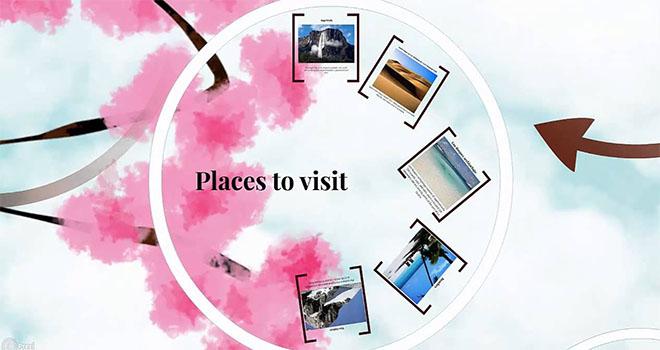
Prezi, shown above, is a popular non-linear presentation tool.
7. Add in a short video
Billions of hours of YouTube are consumed each month and advertisers have identified videos as having a high retention rate for users. However very few presentations ever use videos to engage with their audience.
Find a short video clip that reinforces your story or explains a concept better than words can. You can either embed the video directly into your presentation software or include a link to an external website. Just make sure you test your method on the day of the presentation and have a backup on a USB just in case you need it.
8. Invite people onto the stage
If you’re preparing a particularly long presentation, consider having other people to come on stage and talk for a bit. This will help you narrate the story and make the whole presentation more interactive.
Steve Jobs never pulled off the entire presentation by himself; he always invited several speakers, including designers, partners, and other executives, to help him introduce their latest product. Of course, this technique should always be arranged with your colleagues in advance.
9. Poll the audience
Polls are similar to quizzes in that they engage the audience during the presentation. Polls encourage participants to think not only about your questions but also about their answers. Moreover, live polls help create mental breaks, so your audience can regain attention and stay focused throughout your presentation.
By including everyone in answering the question, you also create a group experience that leaves the audience feeling like they all have been part your presentation.
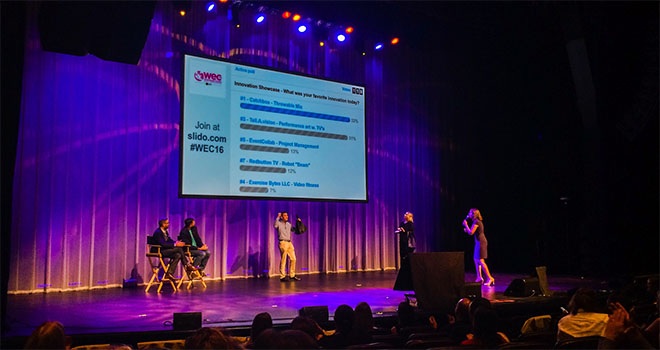
10. Use (appropriate) humour
Some of the best speeches and presentations in the world feature plenty of humour. No matter the subject, a great speaker will use natural charisma, humour and language to convey their points and get the crowd excited about what they are saying.
A great example of building rapport with the audience through the use of humour is Barrack Obama talking about the government building Iron Man.
Another example is when Morgan Spurlock offers individuals the opportunity to buy the rights to name his TED talk—which he refers to again at the end, where he reveals the title. He peppers the entire presentation with humorous commentary that nonetheless supports his point.
Create relevant jokes or find a way to bring out the humour in your subject, and your audience will be much more engaged and more likely to remember your words.
11. Practice your delivery, again and again
Practicing is the most important part of delivering an interactive presentation. You’ll need to practice where to use live quizzes, when to accept questions, which points to emphasise with body language and many more. There are several options for practicing:
Practice Presentation Skills
Improve your public speaking and presentation skills by practicing them in realistic environments, with automated feedback on performance. Learn More
- In front of a mirror – great for seeing and improving your body language, however it can be distracting to what you are saying.
- To friends or colleagues – a useful way to get feedback on your presentation, try and action the feedback straight away to improve on it. You can also give the person some key areas to focus their feedback on if you believe you are weaker in those areas.
- Virtual reality – practice in realistic public speaking environments , whether it be in a virtual conference room or boardroom. Receive feedback on your speech with voice analysis technology.
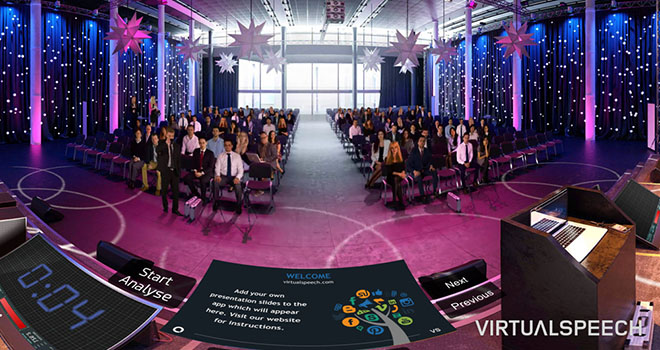
With all three of these, you’ll want to work on your tone of voice, accent, pauses between sentences and facial expressions. The most important thing is to talk slowly and loudly enough to be heard and understood clearly.
A list of the best presentation skills courses you can practice with:
- Presentation Skills Training Courses
12. Try and relate to the audience
Make comparisons to events from everyday life that most people are more than familiar with. By making things look simple, not only will you help your audience get a better understanding of the subject by enabling them to visualize the information more clearly, you will also draw a connection between you.
After all, you are all just regular people with similar experience, you just happen to be performing different roles at the moment.
13. Strong body language (position, posture and gesture)
Non-verbal communication plays a large part in how we construct meaning, so it makes sense to consider how to use it in your presentation. You can make things more interesting for your audience by using your body language to enhance what you’re saying.
Body language goes beyond reinforcing your messaging – it’s useful from a biological standpoint. As discussed in her body language TED talk , Amy Cuddy’s research found that using ‘assertive’ body language released testosterone and reduced cortisol in both men and women, thereby increasing confidence and decreasing stress.
An effective presenter pays close attention to the physical relationship with her/his audience. If you stand hidden behind an overhead projector or stand too far away from your audience, they will not develop a bond with you and this will limit the effectiveness of your presentation.

Your posture will also dictate levels of audience involvement. If you’re too relaxed and sit slumped in a chair to deliver your talk, the audience might drift away. Find a comfortable but purposeful position in relation to your audience and adopt an upright sitting or standing posture that allows for movement and gesture.
Audiences respond well to the physical energy and enthusiasm being conveyed by a presenter, and thus the use of clear and controlled gestures will greatly enhance your presentation. Gestures that are open and reach out to your audience serve to extend your presentation to them and thus help them feel more involved.
Examples of good body language:
- Use hand gestures when delivering key points
- Use calm, deliberate movements when highlighting certain information
- Keep arms and legs uncrossed
14. Maintain eye contact with all sections of the audience
Making eye contact is one of the most powerful techniques for involving your audience. If used well, eye contact can serve to make your address much more personal and thus more effective. If eye contact is avoided, the presenter can appear to be nervous and unconvincing.
It is important to share eye contact with all members of a small audience or all sections of a large audience. Avoid making eye contact with just the people you know, taking particular care not to deliver your entire presentation to the person who’s assessing your work. Remember that you will need to involve the whole audience if you are to make an effective presentation.
If you are nervous, eye contact can be very difficult to establish and maintain. Remember that some eye contact is better than none and that you should try to build your confidence over time.
15. Use live quizzes to better understand your audience
Live quizzes are a great way to understanding your audience better get them engaging with the material.
For example, if you’re giving a presentation on autonomous vehicles, you could ask questions such as:
- When do you think autonomous vehicles will become mainstream?
- Are you concerned by safety issues?
- If someone is injured or killed by the car, who is to blame?
These will surely create some interesting results which you, as the presenter, can talk about and discuss.
16. Use physical props if possible
You don’t need to be giving a product demo to use props during your presentation. Props are a great way to help the audience visually picture what you are talking about. While talking through your presentation, you can refer to the prop at certain points to highlight your point or make it clear to the audience.
Kenny Nguyen does this will in his TEDx talk on ‘The Art of Saying No’. He refers to the “sword of yes” and “shield of no.” Naturally he picks up a sword and shield from the table to help demonstrate his points.
Another great example is when Jill Bolte Taylor brings a real human brain on stage during her TED talk to explain to what happened to her when she had a stroke. She touched the audience with this demonstration and left the audience in complete awe.
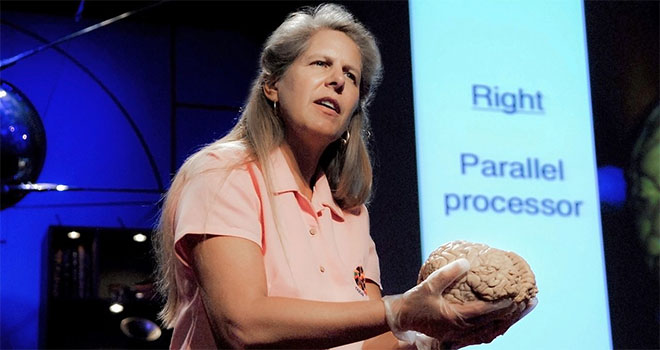
17. Extend your usual vocal range
Your tone of voice, your volume, and other vocal aspects affect how people listen and hear your message.
Julian Treasure’s TED talk on ‘How to speak so that people want to listen’ is all about this, and at the end offers several tips ‘in our toolbox’ for how to master the use of voice, from changing your speaking pace to speaking in a different pitch.
Get feedback from a friend or colleague to see what works best for you.
18. Use language and literary techniques
Your use of language has a huge influence on the way you engage your audience. It’s important to use language your audience understands and is familiar with.
Avoid using language that is too formal or informal, too technical or too simplistic depending upon the nature of your talk and the knowledge base of your audience. Pitching your presentation at the right level can be a challenge but it is very effective for making the audience feel involved.
There are various literary techniques you can use, such as the Power or Three, to give greater impact to your message.
Involving your audience is essential to making an impact. Your presentation should pull them in, get their attention and stimulate their thoughts and understanding. This can be done in a number of ways.
The way that you plan your presentation will be critical in terms of using language and ideas that your audience will understand. You must also ensure that there is sufficient time for questions and discussion. The way that you deliver your presentation should create a bond with your audience.
Your use of eye contact, body language, spoken words and energy should communicate effectively and enthusiastically with all areas of the room, thus ensuring that the audience receives positive messages about you and your material.
The HOUSTON NOVEMBER 7-8 PUBLIC SPEAKING CLASS IS ALMOST FULL! RESERVE YOUR SPOT NOW

- Public Speaking Classes
- Corporate Presentation Training
- Online Public Speaking Course
- Northeast Region
- Midwest Region
- Southeast Region
- Central Region
- Western Region
- Presentation Skills
- 101 Public Speaking Tips
- Fear of Public Speaking
How to Encourage Audience Participation During Your Presentation

Audience Participation is an excellent way to make a good presentation into a stellar presentation. It can also be the scariest. That is why most speakers — even seasoned professionals — avoid asking their audience questions. It is too risky. Or is it?
The truth is that the types of audience participation that most speakers use can come across as cheesy or forced. Also, our audiences have been trained to not interact with us. From the time we are in grade school, we are trained to sit still and listen to the speaker (teacher.) Here is the good news, though. Presenters who get really good at audience participation can boost audience engagement dramatically and make each presentation a positive experience for their audiences.
So below, we’ve organized the tools in three parts. Part one covers different ways to encourage audience participation based on how introverted or stoic your audience is. Then in part two, we cover the best techniques to use during the interactive presentation to boost engagement. Finally, in part three, I cover some additional ideas that you want to avoid because they can be risky. By the way, these are the techniques that most speakers try first. Then, when the technique backfires, it makes the speaker less likely to want to ever try again. Again, though, if you avoid the ideas in part three, you have a strategic advantage over other speakers. As you begin to master these skills, you will be seen as a more professional speaker and presenter!
Want to beat stage fright, articulate with poise, and land your dream job? Take the 2-minute public speaking assessment and get the Fearless Presenter’s Playbook for FREE!
Special Warning about Post-Pandemic Live Polls and Other Technical Audience Participation Tools.
During the pandemic, virtual event organizers found creative ways to keep their audience’s attention during each virtual event. A couple of these virtual audience engagement tools were live chat and the live polling. The technology was added to try to add more interactive elements to the virtual meeting.
Unfortunately, though, this technology just reinforced bad habits. A good team communicates with each other and shares ideas confidently. And a good presenter creates a conversation with his or her audience. This technology didn’t really help with either of these things. In fact, it probably made communication more difficult. So, be careful about inserting these tools into in-person events. You get a much better result by just interacting with your audience verbally.
The Three Absolute Best Ways to Encourage Audience Participation During Your Presentation.
Some audiences will be eager to participate. We call this type of group an engaged audience. However, other audiences will be more stoic. Remember most audience members have been trained to sit still and be quiet during a presentation. So the ideas below can help you get even the most introverted audience to interact with you.
The process all starts, though, with the goal to create a dialogue with the audience versus a monologue. The longer that a speaker talks without getting the audience to do something or say something, the more bored the audience will be.
So a great technique is to ask the audience a question where they can voice their opinion.
Ask an Open Ended, Opinion Asking Audience Participation Question.
The absolute easiest of these audience engagement strategies is to just turn one of your key points into an opinion-asking question. When you do this, instead of you having to prove your bullet point to your audience… Well, you ask the audience to prove that the bullet point is true.
This technique is really simple if you have a well-developed bullet point that includes a result that your audience wants. Here is an example.
Standard Bullet that Most People Would Use.
- Five or Fewer Bullet Points in a Presentation.
However, this bullet has no result built into it. So, as the presenter, I can just ask myself, “If someone does this action, how will he or she benefit from it?” The answer to that is that the person will become a more concise speaker. So, I just add that to the bullet point.
- Limit Your Presentation to Five Main Bullet Points to Become a More Concise Speaker.
At this point, an open-ended question is easy. I just add the words “In what ways would…” to the front of the statement to make it into a question.
In what ways would limiting your presentation to five main bullets help you design a more concise presentation?
So, if I tell the audience my bullet point, I then have to prove to them that the bullet is true. However, if I ASK the bullet in the form of an opinion-asking question, the audience will then prove my bullet point to me.
Think, Write, Share.
The “Think, Write, Share” activity is a fantastic way to get your group to give feedback to you. Before I explain the technique, let’s discuss why it is valuable. Quite often, especially in training sessions, we really want to ensure that the audience understands what we have delivered. We also want to make sure that the audience retains the information. So, many new speakers will just ask the audience a question about the content. Of course, audience members will often be self-conscious about speaking to the group about content that is still fairly new. As a result, the feedback will be minimal.
A better technique is what we call, “Think, Write, Share.” Have the audience think about the question that you ask. After a few seconds, have them write down possible answers. After the group has written quite a bit of content, only then do you ask them to share the content.
For instance, I often start my presentation classes with a question like, “Think about all of the different physical things that happen to a person’s body when he or she gets nervous speaking. (Pause for a couple of seconds.) After you have thought of a few of these things, write down two or three that occur most often. (Wait for everyone to have at least one item written down.) What were some of the things that you wrote down?”
The beauty of this technique is that we aren’t putting anyone on the spot. If the person wrote something down, then he or she will not likely be uncomfortable reading the thing that they wrote to the group. It is an easy way to get the entire group to participate.
Group Discussion and Reports
A variation of Think-Write-Share is Group Discussion and Report. You basically just divide your audience into small groups of five to six people. You can either give each group a different question or have all of the groups ponder the same question. Then, give them a couple of minutes to discuss their question as a group and come to a consensus. Finally, have one member of the group give a report of their findings.
I often use this technique in classes after I assign an activity where groups will be working independently for some time. For instance, in my leadership classes, we have an activity on group problem solving where each group will be practicing the skill independently of each other. As a result, the groups may finish at slightly different times. So, I’ll have the first group begin to discuss summary questions as a team. As each other team completes the activity, I’ll give them the same questions. Once all of the teams are finished with the original activity, I have all of the groups report on the answer to the question. That way, no group is sitting around doing nothing.

Audience Participation Techniques to Get the Audience to Want to Participate.
Of course, good audience participation isn’t just about asking the right questions. There are also important techniques that you can use to (1) get your audience to answer the questions and (2) get more members of the audience to want to chime in.
Try these ideas.
Once You Ask the Question, Wait for an Answer.
When we ask a question of the audience, we often slip into a strange, Star Trek-like, space-time continuum where time slows down. It is easy for a presenter to ask a question, and then right away, answer the question ourselves. It seems like we have been waiting for a long, long time, but in fact, it has only been a slit-second. Quite often, when we ask a question of the audience, the participants want to think about their answers a little. So, it will sometimes take a little longer to get the responses. Don’t worry. If you asked a good question, they will respond.
If You Get No Responses, Re-Ask the Question a Different Way.
If you get answers different than you were expecting or don’t get any answers at all, take responsibility for the mistake. Something like, “Let me re-ask that question. I don’t think that came out right,” is a good way to get the audience focused on the new question.
Give The Audience Atta-Boys.
One of the most important secrets to getting great participation is to positively reinforce the action that you want to encourage. So, when you ask a question of the audience, you want to do two specific things.
- Give an Atta-Boy : Repeat or rephrase the response and tell the person who gave the response how what he or she said was true. For instance, if I asked what happens to speakers when they feel stage fright, and an audience member said, “faster heart rate,” I might rephrase what he said by saying, “Right, the heartbeat speeds up.” If you think about the risk that the person is taking by speaking out loud, you can see how if we don’t reinforce the comment, the person may wonder if what he said was correct. For instance, if I said, “Hhhmmm… Faster heart rate?” and stopped, most other people in the audience will now not want to take that same risk. No one wants to be embarrassed by the speaker.
- Write It Down : Write down the response on a flip-chart or whiteboard. When people see their words on the board, it makes them think that what they said was important. This little measure will both help you build rapport with your audience and help you remember what everyone said. That way, you can use all of the responses as a way to summarize the concept one final time.
A Few Other Types of Audience Participation that Are Riskier. So Proceed with Caution.
Remember, the goal is to open up lines of communication with your audience. You don’t want to make the audience feel like you are manipulating them or forcing them into a box. So be very careful if you decide to add any of these techniques to future events. These are the types of audience participation that typically turn audiences off.
Rhetorical Questions
These are questions that we ask that have an obvious answer. In fact, in most cases, we don’t really expect the audience to answer. I have to admit, when I was being trained as a speaker, my mentor told me to, “Never ask a question of your audience unless you really want them to answer.” The reason for this advice is that rhetorical questions have a high propensity to be seen as being manipulative. Obviously, if your audience feels like you are trying to manipulate them, they will react negatively.
However, audiences trust speakers who they can relate to. They trust speakers who are like them. So, if you begin your presentation with a statement that everyone in the audience will agree with, it can sometimes build that rapport. For instance, I might start a presentation class with a statement like, “Would you agree that most people have at least some type of public speaking fear?” Another option might be, “Would you agree with me that most business presentations are pretty boring? So if you are just a little more interesting than the last person who spoke, your audience will think you were great, right?”
Yes/No or Show of Hands Question
Personally, these types of questions are not my favorite. I tend to not use these a lot, myself. However, they do have a certain use. This is a great way to call attention to a group that you want to set apart as elite. For instance, if you have the top salespeople stand at the sales convention, you make the ones that had to remain sitting think, “I want to stand up next year!”
One of my friends leads big 300+ person seminars where he charges a nominal fee for attendees to come to the seminar. However, he has a smaller group of attendees who participate in his one-on-one ad group coaching sessions, and they pay an extra fee for this service. Anytime he has new openings in this coaching group, he will recognize the group at one of his big meetings. He will just say something like, “Can I have all of my Platinum Group please stand?” Then as they are standing, he will say something like, “If you have questions about any of the content that I’m covering, make sure and ask one of these folks.”
Basically, by separating out the coaching group, he has generated interest from the audience. Quite often, he will have participants coming to his registration table asking about how to join the group before he has even started to promote it. So, later in the meeting when he hands out the application to the entire audience, he gets more applications returned.
A Contest or Game
If you want to reinforce content that you have shared earlier in your presentation, sometimes a game or contest can add some fun.
Back when I used to do a lot of sales training, I used to use this technique a lot. Salespeople are really competitive. (They also don’t pay attention to training much, LOL.) So, if I had a two-day sales course, I might end the first day with a Jeopardy-style game show. I’d divide the class into a few teams, and the winning team might win gift cards. Obviously, this isn’t going to be the best way to end all meetings, but in certain situations, it works really well.
Use Audience Participation in Your Presentations to Make them Interactive
Regardless of which type of activity you choose, add in some type of audience interaction. It will make your speeches much more fun and interesting!

Podcasts , presentation skills
View More Posts By Category: Free Public Speaking Tips | leadership tips | Online Courses | Past Fearless Presentations ® Classes | Podcasts | presentation skills | Uncategorized
Looking to end your stage fright once and for all?
This 5-day email course gives you everything you need to beat stage fright , deliver presentations people love , and land career and business opportunities… for free!

How To Engage An Audience In Presentation: 10 Expert Tips

In the fast-paced world of presentations, captivating your audience’s attention is essential. Whether you’re a seasoned speaker or a novice, knowing how to engage an audience in presentations is a valuable skill. Effective engagement ensures your message is heard and remembered. In this article, we’ll share ten expert tips to help you connect with your audience and make your corporate event more impactful.
Start with a Compelling Story
Begin your presentation with a captivating story that relates to your topic. Stories have the power to draw in your audience emotionally, making them more receptive to your message. Whether it’s a personal anecdote or a relevant case study, a well-told story sets the stage for a memorable presentation.
Use Visuals Wisely
Visual aids can enhance your presentation , but they should complement your message, not overshadow it. Incorporate images, graphs, and charts that support your key points. Keep slides clean and uncluttered, using visuals to reinforce your spoken words rather than reading directly from them.
Interact with Your Audience
Engage your audience by asking questions, encouraging participation, or conducting polls and surveys. Interaction not only keeps your audience involved but also provides valuable insights and feedback. Be sure to listen to their responses and incorporate their input into your presentation where relevant.
Maintain Eye Contact
Establish a connection with your audience through consistent eye contact. When you look directly at your listeners, it conveys confidence and sincerity. It also helps you gauge their reactions and adjust your presentation accordingly. Avoid constantly reading from notes or slides; instead, engage with your audience.
Use Clear and Concise Language
Simplicity is key to effective communication. Use clear, straightforward language, avoiding unnecessary jargon or technical terms that your audience may not understand. Explain complex concepts in a way that anyone can grasp, and keep your sentences concise and to the point.
Tell Them Why the Presentation Matters
Clearly articulate why your presentation’s content is relevant and beneficial to your audience. Address their pain points or concerns and explain how your information or solution can address them. When your audience understands the value of what you’re saying, they’re more likely to stay engaged.
End with a Memorable Call to Action
Conclude your presentation with a strong call to action. Summarize your key points, restate your main message, and clearly state what you want your audience to do next. Whether it’s taking a specific action or considering a new perspective, a compelling call to action leaves a lasting impression.
Incorporate Real-life Examples
Illustrate your points with real-life examples and case studies. Sharing practical experiences helps your audience relate to your message and see its practical applications. Whether it’s success stories or lessons learned from failures, real-life examples add depth and authenticity to your presentation.
Use Visual Analogies
Visual analogies can simplify complex concepts and make them more relatable. Compare abstract ideas to familiar objects or situations, helping your audience grasp the essence of your message. Visual analogies enhance understanding and engagement.
Encourage Questions and Discussion
Invite your audience to ask questions and participate in discussions throughout your presentation, not just at the end. This ongoing dialogue fosters active engagement, encourages curiosity, and allows you to address specific concerns or interests.
Mastering the art of audience engagement in presentations involves storytelling, interactive elements, visual clarity, clear language, relevance, impactful closure, real-life examples, visual analogies, and ongoing interaction for a lasting impact. Remember, the ability to connect emotionally, simplify complex ideas, and foster a two-way dialogue are crucial elements that, when combined, create a compelling and unforgettable presentation experience.
Related posts:
No related posts.
Contact Us: Submit Inquiry
- Virtual Sets
- Studio Broadcasts
- Augmented Video
- Corporate Storytelling
- Venue Expertise
- Visual Identity
- Brand Design & Application
- Events, Meetings & Conferences
- Exhibits & Trade Shows
- Experiential Activations
- Apps & Gamification
- Live Action, Special Effects & Motion Graphics
- Sound Design & Custom Music
- Virtual, Augmented & Mixed Realities
- Custom Print & Fabrication
- Permanent Installations
- Stage Design & 3d Rendering
- Case Studies
11 Engaging Ways To Interact With The Audience
Hrideep barot.
- Body Language & Delivery , Presentation

While delivering a speech, have you ever glanced at the audience to see their reaction to what you’ve said, only to realize that there is no reaction at all because almost everybody has zoned out? Alternatively, have you ever found yourself sitting in the audience, daydreaming your way through an incredibly boring speech?
In both of these cases, it wasn’t the audience but the speaker who was responsible for the audience’s lack of attention.
That’s because it’s the speaker’s responsibility to interact with the audience, and to deliver a speech that’s not just informative but also engaging.
And avoiding–sometimes downright shaking off–this onus is a mistake that many, many speakers make. Often at the cost of the success of their own speech.
Audience Participation is active response by an audience to a live show or broadcast.
Grabbing and holding onto the audience’s attention is not an easy fear. However, it’s not impossible either.
If you don’t want crickets from the audience the next time you deliver a speech, it’s important to not deliver crickets from your end too. That is, don’t just dive into your speech and refuse to resurface from it. Instead, you need to interact with your audience. You don’t have to talk at them. You’ve got to talk to them. And since talking is a two-way process, you want to hear their response too.
Interacting with the audience might sound difficult, but it’s not, really.
There are many engaging ways of interacting with the audience, like playing games, having live Q & A sessions, getting them to join you on the stage, using props, and organizing Give-Aways!
The strategies you chose depend on the overall goal as well as the duration of your speech. Also, you need to do some advance preparation by researching your audience and what it’s going to be primarily composed of.
But first, why should you interact with the audience?
Importance Of Interacting And Connecting With The Audience
There are many reasons why it’s absolutely imperative for a speaker to interact with their audience. One of the primary reasons is that speeches often last for a very long time. Interacting with the audience gives them a reprieve from listening, and offers them an opportunity to speak out. This makes them feel more involved with and connected to the event and with you i.e the speaker.
The interaction will also work to make your talk memorable, and make the audience connect with you. If the audience has fun and feels a kinship with you, they will make conscious attempts to pay attention to your speech and engage with you. Also, it’s more likely they will be drawn in to hear you speak again in the future.
Another reason why it’s important to interact with the audience is because audience’s attention span is limited. If you don’t successfully keep them engaged, then sooner or later, they will start fiddling with their phones or simply zone out. Yikes!
Engaging Ways To Interact With The Audience

Now that you know the importance of audience interaction, let’s move onto the next step: how to interact with the audience.
1. Tell A Story…And Ask Them To Guess The End
Stories are a necessary ingredient in most public speeches. This is because they lend a personal note to the talk, and make the experience more memorable for the attendees. However, one way of taking storytelling up a level is to involve your audience in it. A great way of doing that is by asking your audience what you think will happen next.
This will make your audience think and even analyze what you’re saying. This renewed attention is likely to last for longer than the duration of your story and to spill into your general talk, as well.
Even better: ask your audience what happens in the end, but don’t immediately tell them if they’re right. Hold onto the ending for a while, and weave in the answer where you feel it fits better during the rest of your talk. For instance, when you feel like you’re beginning to lose their interest again–throw in that ending!
The following is a great example of how you can use storytelling to ramp up your presentation! Notice the speaker’s body-language, their story selection, as well as the delivery of the same.
2. Ask Them Questions
Another great way to make your presentation interactive is by asking your audience questions. Like guessing what happens next in a story, this will pique their interest, and get those analytical wheels in their head turning.
You could directly ask an audience member a question. Or, you could request the audience to answer with a show of hands. There are many ways of going about this. Just make sure that you prepare your questions beforehand.
Here’s an excellent way through which you can incorporate questions to ask your audience! Notice how the audience interaction improves with the speaker actively asking them questions.
3. Use Props!
Another excellent way of engaging your audience is by using props. Props not only make the presentation more fun and visually appealing, but if used right, will also make it easier for the audience to understand your message.
However, one thing to keep in mind before using props to spruce up your presentation is to keep in mind that the prop shouldn’t just be an added accessory. It’s not just there to be an entertaining element. Don’t choose a prop that seems redundant.
Rather, choose a prop that drives forward the point you’re trying to make. There are many props that you can use: a chair, a doll, a stick, a flower…Anything can be turned into a prop!
Below is an excellent example of how you can effectively use props to ramp up your presentation! Keep an eye on the speaker’s use of prop, and the way they use it to make the presentation better!
4. Play A Quiz!
Another way to engage your audience more deeply in your presentation is by quizzing them!
If you wish to quiz the audience to get an idea how of how familiar they are with the topic, you can add the quiz at the beginning of your speech. This can be a great bonding experience for them. Alternatively, you could add the quiz somewhere in the middle of your presentation, when you feel like the audience’s attention has begun wandering to other things.
Like the props, make sure that the quiz is relevant to the topic at hand. Also, keep in mind to prepare the questions beforehand. If you don’t want to hand out actual papers to the audience, you could have them directed to a website that they can use to solve the quiz on their phones.
Following is a how to on making an interactive quiz using PowerPoint! You can use the format in the video. Alternatively, you could take inspiration from it and come up with your own idea or go the other way and use a quiz website!
5. Invite Them To Join You On The Stage!
If you want to take the audience’s involvement in your speech to the next level, you could invite them to the spot traditionally thought to be reserved for the speaker: the stage.
This is an excellent way of adding a kick of anticipation to your speech.
There are many ways in which you could do this. You could ask for volunteers, and then invite them on stage for an activity or game. Or, you could ask if anyone would like to add something to what you’ve just said, or talk about their experience, and hand over the mic to them!

6. Alternatively…YOU Get Off The Stage!
If you aren’t comfortable inviting people on stage, you could go the other way and step off of it yourself.
This is an amazing opportunity to directly interact with the audience and to make them feel like you’re one of them. Direct, face-to-face interactions with the audience members are a great, great way of making your speech memorable. Not just this, but the increased proximity adds that personal touch to the speech that so many speeches lack.
So, next time you’re delivering a speech, don’t be scared to push past the boundaries of the stage!
7. Get Them Moving!
Having to sit still for prolonged periods of time is a doorway to boredom. And boredom is what makes the audience tune out your awesome speech.
So, if you feel like you’ve spoken for a long time without giving your audience a break, get them moving! You could do this by making them play a game. Or, you could simply request them to stand and do a couple of fun exercises like clapping their hands or jumping!
Not only will it increase the overall energy level in the room, but it might also successfully draw out that sought-after burst of laughter from the audience!
Ellen DeGeneres is known for her audience interaction! Here’s a clip of how she keeps her audience moving! You can take inspiration from her approach to improve your audience’s engagement and get them moving!
8. Play Games With Them!
Who doesn’t like a good game, right? Especially if it’s a two-hour presentation, games are a great way of refreshing your audience and giving them a break from the monotony of listening.
Also, games don’t necessarily have to be just for fun and frolics. You can customize a game that actually adds to your topic. For example, you could use live polls or have a live Q & A on a website. You could also have an impromptu debate competition to give them a chance to tell what they think about the topic.
9. Get Them To Tweet
Gone are the days when cellphones were a luxury–or a distant dream. Today, anybody and everybody have a cellphone in their pocket. Although the general goal is to keep the audience’s attention off of the cellphone and focused on your presentation, there are ways in which you can use to your advantage the underlying human instinct of fingers twitching towards phone screens.
One way of doing this is by using Twitter. You can have a unique hashtag for your talk, and encourage the audience to tweet their questions, suggestions, or ideas on it. Then, address them live! This is an excellent way of engaging people who are shy or simply don’t wish to speak up.
10. Invite An Expert Panel
An expert panel is a great way of piquing your audience’s interest. Inviting guest speakers also gives the audience a break from having to listen to the same speaker for long stretches of time, and also makes it a more educational experience.
However, make sure that the speakers are relevant to and well-versed with the topic at hand. You could ask the audience to prepare any questions that they’d like to ask the speakers in advance. This will keep them interested and engaged throughout. Also, having distinguished speakers will improve the attention level as well as anticipation for your event!
Following is an excellent expert panel discussion that shows how it can improve audience’s interest during a speech! As you watch, try understanding why particular experts were invited to the panel. You can use the information to invite a panel to your discussion, depending on the topic at hand.
11. Incorporate Giveaways And Gifts!
Giveaways are a great, great way to increase your audience’s excitement levels. After all, who doesn’t like to win something, right? You could have a prize for a game, or simply give a small token of your appreciation to the audience at the end of your speech.
The giveaway doesn’t necessarily have to be something grandiose either! In a room full of people, the chance of winning even a small gift will work to boost anticipation–and competition! Also, gifts can also be branded to work as a Brand Goodwill, which will work to promote your company!
Need more tips for how to interact with the audience? Check out our article on Interactive Presentations: 7 Foolproof Ways To Engage The Audience!
12. Adding Augmented Reality
Another excellent way of getting the audience up and engaged is by using augmented reality. Virtual event planning is in high demand, and while the cost might be a little steep, it definitely pays off. That’s because AR is slowly seeping into all aspects of our life, and events are no exception!
AR is an excellent way to visually engage the audience. Not only this but its relative “newness”, when compared to the other items on this list, make it a novel and memorable audience experience. It also boosts audience interaction and makes the event more lively and fun.
So, if you can work through the tech and cost required, make sure to use it in your next speech!
Here is an example of how augmented reality can be employed to take your presentation’s visual engagement to another level! As you watch, keep a careful eye on the speaker as well as how they use AR to draw in their audience.
Here is an example of augmented reality use in a presentation. As you watch the video, notice the way in which the speaker employs the technology and drives forth his point
13. Introduce A Fireside Chat
Fireside chat are another great way to boost your audience’s involvement. Fireside chats are an excellent alternative to traditional Q & A sessions and speeches. So what’s a Fireside Chat? Basically, a Fireside Chat is an informal conversation between a presentation moderator and the audience. The concept has evolved into a two-way debate and has been popularized by tech startup community events like TechFire and StartUp Grind.
Fireside Chat are an excellent way to glean the audience’s insight in a first-hand manner. If done successfully, they can make the speech or presentation a wholesome, interactive and unforgettable experience.
The following video demonstrates how having a Fireside Chat can boost the audience’s overall experience and also make it a better experience for the speaker. As you see it, keep a lookout on both: the audience as well as the moderators and how they both interact with each other.
The following video demonstrates how having a Fireside Chat can boost the audience’s overall experience and also make it a better experience for the speaker. As you see it, keep a lookout on both: the audience as well as the moderators and how they both interact with each other.
14. Using Live Barometers
Live Barometers are an excellent method to not only engage the audience but also to get their insight into important parts of the presentation. Live Barometers, also called body voting, involves the moderator introducing a statement to the audience. Say, something like, “The Glass Ceiling Doesn’t Exist.”
Next, the audience members move either left or right depending on what they feel about the statement. The degree to which they move depends on how much they agree/disagree with the statement.
Next, the moderator can ramp up the interaction by asking people why they feel a certain way about the presentation. Audience members can also debate with each other. If, by the end of the session, someone’s opinion alters, they can move along the two extremes!
Here’s an excellent example of how you can incorporate live Barometers in your speech to make it more engaging & how you can frame your questions for the audience.
Here’s an excellent example of how you can incorporate live Barometers in your speech to make it more engaging & how you can frame your questions for the audience.
15. Gamefying The Presentation
If you don’t want the audience to be physically moving while playing a game, you could also have them play virtual games. Virtual games not only add a dose of fun, but they are also more feasible as not all members are required to physically move, which can be a barrier if you have limited space.
There are many different games that you can get the audience to play. Polls are one example. You could also have a live quiz set up for the audience. You could also have a trivia–or even play charades!
16. Using Videos
Using Videos in your presentation to increase audience’s interest might sound like overused advice, however, it’s overemphasized for a reason. Videos are an excellent, cost-effective way to add a dose of creativity to the presentation.
If you’re on a tight budget or have time constraints that make it difficult to be more creative with your involvement tactics, sticking to the basics is a great way to not totally neglecting it. Videos provide a reprieve from the monotony of a slideshow, and if your lineup is creative and novel, videos can work just as well as the other elements mentioned above!
Understanding The Learning Pattern Of Your Audience
If you want to have an out-of-the-ordinary and personalized strategy to ramp up your audience’s engagement, figuring out their learning pattern well in advance is a great way to go!
We’ve written extensively on this topic here 6 Types of Learners (And How to Speak Them for Maximum Impact) . But you can read on to get the gist…
Broadly speaking, people’s learning types are as follows:
Here is a more in-depth explanation of how you can use the audience’s learning pattern to make your presentation more interactive:
Visual/ Spatial Learners
Visual Learners gain information through visualizing relationships and ideas. They learn from essays, charts, diagrams, maps, pictures, etc. i.e through a variety of visual elements.
How To Engage Them: If you wish to engage them, ramp up your use of the above-mentioned elements in your presentation, and also use videos, games, props, and Augmented Reality!
Solitary Learners
Solitary or interpersonal learners prefer learning alone, as opposed to learning with other people or a crowd. They retain information best when they’re doing it by themselves, rather than when they have company.
How To Engage Them: While it’s not possible to be physically alone during a jam-packed presentation, you can use their individualized temperament by employing interactive methods that require them to work alone like quizzes, using Twitter, having a one-on-one discussion by inviting them on stage, having individual giveaways, etc.
Kinesthetic Learners
As the name itself explains, kinesthetic learners have a more hands-on approach to learning, as they learn through the use of their body and experiential learning. They learn through body and hand movements, and by physically manipulating objects in their surroundings.
How To Engage Them: To involve this type of audience, it’s best to use live Barometers, getting them moving, giving physical giveaways, and playing live games.
Reading/Writing Learners
Writing Learners have a learning pattern that follows putting things into pen-and-paper to glean a better understanding of things. They learn through text perusal, note making, exhaustive research, etc.
How To Engage Them: If you feel that your audience is going to be composed majorly of writing learners, then increase your use of quizzes, questionnaires, and surveys to ramp up their involvement.
Group/Interpersonal Learners
These types of learners learn best with group collaboration rather than by themselves. They’re the opposite of solitary learners, and work excellent in group settings and with other people.
How To Engage Them : Group discussions, team games, panel discussions, fireside chat, etc. Are great ways of getting them up and involved in your presentation!
Auditory Learners
Auditory learners, as insinuated by the name, learn best when information is narrated or verbally spoken. Learning, for them, is better done through means like a creative song, or a podcast, or other auditory mediums.
How To Engage Them: If you wish to involve them better in your presentation, then the best way to do so is by using audio stimuli like group discussions, podcasts, videos, live debates, physical and virtual games, etc!
How Do You Get The Audience To Participate?

You’ve done the research. You’ve done the prep. And so, using every ounce of your courage, you go ahead with your strategy to engage the audience…
…And they don’t respond.
What do you do in this situation?
Do you just give up and move onto the next part of your speech?
Or do you attempt to get them to engage again?
Hint: It’s the second option.
To help you out, here are a few ways using which you can deal with an unresponsive audience:
1. Focus On The Ones Who Are Responsive
When a presentation isn’t going as expected, a lot of us tend to hyper focus on the bad instead of the good. This might make you even more nervous, and cause you to mess up your presentation.
So, instead of focusing on those who aren’t paying attention, try to keep your eyes on the ones that are. Involve them further in your presentation. It will help you plow through the rest of your speech with confidence.
2. Encourage Them To Participate
There are many ways in which you can do this. You could directly ask someone to answer a question. Or, if you prefer a more roundabout way, you could ask the question to the audience in general. It’s important to create an atmosphere that encourages audience participation. Don’t shut down people if you don’t agree with what they’re saying.
Let them speak, and then tell them respectfully where you think they went wrong. Don’t lose your cool if someone asks too many questions or keeps repeating the same question. Also, try and give the audience regular breaks to collect their thoughts and themselves.
3. Change Your Strategy
Another way to get the audience interested is by switching up the format of your speech. While this might seem daunting at first, if you’ve practiced your speech well enough, shuffling things around shouldn’t be that much of a problem.
So, if you’ve just wrapped up a long stretch of talk and feel like you’ve lost the audience and the next part of your speech involves more talk…
Switch it up.
Push ahead that Q/A you’ve saved for the end of the speech.
Or, play that game you were supposed to play halfway through your presentation.
Switch your strategy!
4. Don’t Take It Personally
Another important thing is to not take your audience’s lack of attention personally. Or, even worse: To get offended and let them know you’re taking it personally. There’s nothing worse then losing your cool at the audience, and once you do this, there’s no going back.
Rather than letting it get to you, move on. If you get angry or let your frustration show, it will show the audience that you’re truly not worth their attention. Not to mention you’ll lose the few people who were actually interested in what you had to say–as well as future public speaking opportunities that might’ve come your way from someone watching in the crowd.
5. Make It A Learning Experience
Use what you learned from your experience with an unresponsive audience to prepare for any future instances when your audience might not be as interactive as you’d hoped them to be.
List out where you think you went wrong, what you could’ve done to improve the speech, how the audience reacted to the things you did to refocus their attention, etc.
Next time you’re preparing to deliver a speech in public, prepare in advance. This way, you’ll have a strategy to fall back on if things go south.
Need more tips? Don’t worry! We’ve written article on 5 Ways To Grab An Audience’s Attention When You’re Losing It! Check it out for some more help!
To sum up, keeping the audience interactive and encouraged doesn’t need to be a daunting task. All you need to do is strategize beforehand by sprinkling interactive activities like games, Q & A sessions, give-aways, etc. throughout your presentation, you can keep your audience’s attention piqued. And keep your cool if things don’t go the way you planned: after all, you can always switch things up.
Enroll in our transformative 1:1 Coaching Program
Schedule a call with our expert communication coach to know if this program would be the right fit for you

8 Steps to Success in the Field of Career Coaching

9 Tips for Writing a Maid of Honor Speech That Tugs at Heartstrings

How the 10,000-Hour Rule Applies to Public Speaking

- [email protected]
- +91 81691 99570
Get our latest tips and tricks in your inbox always
Copyright © 2023 Frantically Speaking All rights reserved
5 Sure Shot Audience Engagement Strategies For Your Next Slide Presentation
- By Judhajit Sen
- April 3, 2024
Engage and Connect
In today’s blog post, we’ll discuss the importance of knowing your audience and how to keep them engaged throughout your presentation.
Whether speaking to a room full of professionals or presenting to a group of teenagers, high audience engagement plays a significant role in delivering a successful presentation.
We’ll explore choosing the right audience engagement strategies to involve your audience, from asking questions to incorporating interactive elements like polls and quizzes. Let’s dive in and learn how to make your next presentation memorable by truly connecting with your audience.
Following are 5 sure shot ways to boost your audience engagement during a slide presentation.
Know Your Audience
Why should you bother tailoring your presentation to fit your audience? It’s simple – you want them to be interested and understand what you’re saying, right? Well, if you make your presentation about things they care about, they’re more likely to pay attention and remember what you said.
Before you start talking, take a moment to find out who you’re speaking to. What are they into? What are their goals and challenges? By knowing these things, you can make your presentation more relevant and appealing to them. It’s like customizing your message to fit their needs and interests. And when you do that, they’re more likely to do something with the information you share.
Think of it like going on a date. You don’t just start talking randomly – you try to find common ground, right? Asking questions beforehand or doing a quick survey can help you understand your audience better. People don’t want boring speeches; they want conversations that inspire them.
Your target audience is the group you’re trying to reach with your presentation. Understanding them helps you create presentations that boost audience engagement. For example, if you’re talking to teens, make it fun and use stuff they like. But if it’s middle-aged professionals, get straight to the point and stick to the facts.
Remember, the key to an engaged audience is knowing them. Do your research, and you’ll leave a lasting impression.
Prepare. Plan. Practice.

To nail your presentation, you’ve got to get ready, plan your approach, and practice until it feels like second nature. Spend time digging into your topic so you know it inside and out. Don’t peek at notes—you’ve got to be comfortable enough to talk about it freely.
Practice is vital, especially if you’re using PowerPoint. Get familiar with your slides, know your stuff, and whatever you do, don’t read directly from them. Boost engagement by being natural and avoid too many facts.
Delivery matters. No one wants to listen to a monotone robot rattling off facts. Ensure you’re prepared and keep the energy up. Memorize your flow, rehearse until it’s smooth, and record yourself to iron out any kinks.
Know your material backward and forward. Nobody likes a presenter who seems as surprised by the slides as the audience. Don’t be that person. Be prepared, check your tech, and get comfy with your software beforehand.
Don’t underestimate the basics. Know your agenda, check your equipment, and familiarize yourself with the software. Nobody wants to watch you fumble around with technical difficulties. Take the time to practice, speak clearly, and get feedback to make your presentation shine.
Tell a Story
Imagine yourself standing in front of a room full of people, all waiting for you to speak. You’ve got a presentation to give, and you want to make sure everyone listens and remembers what you have to say. How can you do that? Well, let me tell you a story.
Once upon a time, there was a young professional named Alex. Alex had to give a presentation at work about effective communication in the workplace. Now, Alex knew that just throwing out facts and figures wouldn’t cut it. He needed something more engaging, something that would grab the audience’s attention and hold it.
So, Alex decided to start the presentation with a story . He talked about a time when a miscommunication led to a big mistake at his company. It was a relatable tale that drew the audience in, making them eager to hear more. As Alex continued, he shared anecdotes and examples, reinforcing their points with real-life stories.
By the end of the presentation, the many audience members were not only informed but entertained. They had laughed at the humorous parts, nodded in agreement during the relatable moments, and even felt a pang of empathy during the more emotional anecdotes.
As Alex wrapped up his presentation, he could see that he had made an impact. The audience was engaged, and he could feel the energy in the room. And all it took were a few well-told stories.
When you’re giving a presentation, don’t just rely on facts and figures. Take your audience on a journey with you. Tell the audience stories that resonate with them, make them laugh, make them think, and most importantly, make them remember. Because, in the end, a good story is worth a thousand metrics.
Nail the Visual & Design Elements

To increase audience engagement and make your presentations truly pop, you need to pay attention to the visual and design elements. Here are some proven strategies to engage an audience:
1. Choose Quality Visuals: Power up your presentations with top-notch visuals like images, charts, and infographics. These add substance to complex ideas and keep your audience engaged. However, visuals should support your main points and not just be there for decoration.
2. Keep it Simple: Don’t overwhelm your slides with too many colors, text, or images. Stick to 2-3 colors, use readable fonts, and leave plenty of white space to enhance readability.
3. Consistency is Key: Use a consistent color theme and background throughout your presentation. This ensures that your slides look polished and professional.
4. Use Multimedia Wisely: Mix up your presentation with multimedia elements like music, videos, and animations. These can enhance your message and appeal to different types of learners.
5. Embrace Movement: Animations and transitions can help emphasize key points and add dynamism to your presentation. Just be sure not to overdo it – too much movement can be distracting.
6. Prioritize Visuals: Remember that visuals are crucial for capturing and maintaining your audience’s attention. Use images, videos, and infographics to simplify complex concepts and make your presentation more engaging.
7. Choose Colors Wisely: Colors can evoke certain emotions and set the tone for your presentation. Follow a color scheme that matches your theme and brand identity, and avoid using too many colors.
8. Pay Attention to Fonts: Your choice of font affects how your audience perceives your presentation. Pick a font that matches the mood and intent of your message, and ensure that it’s readable from all angles.
9. Utilize White Space: Don’t overcrowd your slides – leave plenty of white space to improve readability and ensure that your visuals and text stand out.
By following these simple tips, you can nail the visual and design elements of your presentation, making it more attractive, engaging, and impactful for your audience.
Involve Your Audience
To make your presentation more engaging and keep your audience’s attention, it’s essential to involve them in the conversation. Here are some key ways to do that:
1. Ask Questions: Encourage audience participation by asking questions throughout your presentation. This turns your talk into a dialogue rather than a monologue and keeps your audience engaged.
2. Icebreakers: Start your presentation with an icebreaker to grab your audience’s attention and set a positive tone. This helps build rapport and keeps the audience focused.
3. Interactive Elements: Use polls, quizzes, or other interactive elements to add interest and break up your presentation. This allows your audience to participate and interact with the content actively.
4. Q&A Sessions: Allocate time for a question-and-answer session at the end of your presentation to address any uncertainties and further involve your audience. This fosters dialogue and clarifies points.
5. Live Polling: Incorporate live polling tools to obtain real-time feedback from your audience and encourage active participation. This adds an interactive element and keeps your audience engaged.
6. Humor: Incorporate humor into your presentation to lighten the mood and engage your audience. This creates a positive atmosphere and makes your content more enjoyable.
7. Building Rapport: Connect with your audience by engaging in personal introductions or icebreaker games. This helps establish a rapport and creates a welcoming environment for interaction.
8. Encourage Physical Interaction: Encourage audience members to interact physically with the presentation or presenter. This fosters engagement and encourages deeper thinking about the topic.
9. Gamify Your Presentation: Add gamification elements such as quizzes, games, or challenges to make your presentation more interactive and entertaining. This keeps your audience actively involved and invested in the content.
By involving your audience in your presentation, you create a more dynamic and memorable experience that resonates with them long after the talk is over.
A Guide to Interactive Presentations
In today’s blog post, we’ve explored the importance of engaging your audience and how to foster connection throughout your presentation.
Whether you’re addressing seasoned professionals or a group of teenagers, understanding your audience is critical to delivering a successful talk.
We’ve delved into various strategies for engaging your audience, from asking questions to incorporating interactive elements like polls and quizzes. By connecting with your audience, you can make your next presentation memorable.
Remember, it’s not just about speaking to your audience but engaging them in a meaningful conversation. So, get ready to dive in and create slide presentations that captivate and resonate with your audience.
FAQs about Audience Engagement Strategies
1. Why is it essential to tailor your presentation to your audience?
Tailoring your presentation to your audience is crucial because it ensures that they are interested and can understand what you’re saying. When you make your presentation about things they care about, they’re more likely to pay attention and remember what you said.
2. How can I understand my audience better before giving a presentation?
Before you start talking, take a moment to find out who you’re speaking to. Ask questions about their interests, goals, and challenges. This helps you make your presentation more relevant and appealing to them.
3. How can I engage my audience during a presentation?
Engaging your audience through interactive elements like asking questions, using icebreakers, and including live polling tools can encourage participation and make your presentation more dynamic.
4. Why should I incorporate storytelling into my presentation?
Storytelling helps you captivate your audience and make your message more memorable. By sharing relatable anecdotes and examples, you can reinforce your points and create a more engaging presentation experience.
Engage Your Audience with Prezentium
Are you tired of delivering presentations that feel more like one-sided lectures? Say goodbye to dull slideshows and hello to interactive engagement with Prezentium’s AI-powered business presentation services!
Need a stellar marketing strategy presentation delivered pronto? Email us your requirements by 5:30 pm PST, and we’ll combine business understanding, visual design, and data science to provide a top-notch presentation to your inbox by 9:30 am PST the following business day.
Let our team of experts help you transform your ideas and meeting minutes into captivating presentations. We’ll even assist you in creating new designs and templates to ensure your message shines.
Elevate your communication skills with our interactive workshops and training programs. We blend structured problem-solving with visual storytelling to engage and inspire your audience like never before.
Don’t settle for boring presentations that put your audience to sleep. With Prezentium, you can give your audience dynamic and interactive presentations that captivate, inform, and inspire. Contact us today to learn more about the right audience engagement strategies!
Why wait? Avail a complimentary 1-on-1 session with our presentation expert. See how other enterprise leaders are creating impactful presentations with us.
Communication Strengths: Master 10 Communication Skills in 2024
Positive communication: improving effective communication skills, lack of communication: ineffective communication in the workplace.
Presentation | Public Speaking | Strategy
15 ways to keep your audience engaged.
Written by Kai Xin Koh

Ever wondered why it is so hard to keep your audience engaged? Well, here’s the answer. According to research , the average attention span of a human is eight seconds. And what this means is that your audience are likely to lose their attention during your presentation, and you wouldn’t want that to happen would you?
Delivering a presentation isn’t as easy as it seems, and on top of that, the thought of your audience not listening to you can haunts you throughout your presentation. In this article, we have prepared 15 tips to help you keep your audience engaged during your presentation.
1. Tell stories
“Sometimes reality is too complex. Stories give it form.” – Jean Luc Godard
Ever heard of Shark Tank? Entrepreneurs take part in the show to seek funds from a group of sharks in return for equity for a new product that they have just launched. The way they would pitch about their product is to start with a story that focusses on the problem followed by a demonstration of the product that help provide a solution to it.
So why do they use stories to communicate the problem? Isn’t it easier if they just stated it and moved on from there? Why put in the effort to come up with a story?
Thus, storytelling can play a huge part in helping the audience better understand your point.
Here’s a video of Andy Harrington speaking about the number one way to engage your audience:
2. Eye contact
Most of us have been a victim of painful presentations. Some contain really heavy content, some are filled with numbers and facts, and some are just… boring. One of the ways to keep the audience engaged is to maintain eye contact with them. When you look them in the eye, they are more likely to back at look at you. This way, they get less distracted by other things such as games on their phones and become more focused on you and your content.
3. Start by telling your audience what they’ll take away from your presentation

Imagine listening to a presentation hoping to gain knowledge about a particular something, and the next thing you know, the session is over – turns out, nothing memorable was mentioned, no valuable insight or takeaway from the session.
It would be a plus to inform your audience at the start of your presentation about your agenda or goals so that they know to expect from it. This way, they are more likely to listen attentively and anticipate the information that you’ll be speaking about, which will engage them in your presentation.
4. Emphasise key words
Make it clear to your audience what they really need to pay attention to by changing your tone when it comes to the important information. You can also speak a little softer when you’re emphasising a key point to make the audience focus on you more.
You must be wondering then, why softer and not louder? This is because when you speak softly, people tend to associate it with important things like secrets – which makes them all the more interested in what you have to say.
With that being said, there’s nothing wrong with speaking louder too, though it depends on what the message is and how you would want to convey it to the audience.
You can also consider using the following techniques to emphasize the important points:
- Inform your audience that you are about to say something important.
- Use repetition
- Make the most important point the climax of a story
5. Use silence effectively
Imagine explaining an extremely complex situation or problem to someone. Do you instantly move on to the next point or do you wait for them to process the information before moving on?
This is the same with presentations. When you make a statement, it’s important to wait in silence to observe how people receive the message. Give the audience some time to receive and digest the information. Don’t flood the them with too much information or you’ll end up overwhelming them, which is a sure fire way to lose their interest.
6. Incorporate humour into your presentation

When you have a creative presentation lined up for the audience, you’ve won half the battle. Creative presentation will help to differentiate you from other presenters. What’s left is to maintain their attention towards you throughout the presentation.
Life is too short to be serious about everything. Lighten the mood by incorporating some humor into your presentation to keep the audience engaged. Leo Rosten, an American Humorist, once said “ Humour is the affectionate communication of insight .” I’m sure the audience will be happy to listen to a joke or two during a presentation, especially those with heavy content.
7. Encourage interaction
Ever wondered why speakers say things like “Raise your hands if you agree” or “Raise your hands if you have done this before”?
Doing this helps stimulate engagement amongst the audience. Not only that, speakers are also able to find out if you have been listening through your response.
Here’s a tip: make use of online quizzes such as Kahoot during your presentation Kahoot is a customisable online poll to help kickstart a discussion with your audience. They can take part in the quiz using their electronic devices.
This helps find out if they have been listening to you through their participation and also keep them engaged.
8. Be enthusiastic

Don’t expect your audience to be excited about your presentation when you yourself are not. Be enthusiastic and spread the positive vibes to your audience. Remember, you only have 7 seconds to either make it or break it when it comes to creating a lasting impression on your audience. So start off strong with lots of energy to create a lasting first impression. That way, they are more likely to listen to your presentation as they may find you fun and interesting.
9. Pause periodically
Pauses allows your audience to interrupt your presentation with their burning questions. This way, there will be more interaction between you and your audience, thus they’ll be engaged and involved throughout the presentation. You can also switch the presentation up by asking your audience questions once in a while instead of letting them do all the asking. This also helps them to ponder over the issue that you’ve brought up.
10. Alternate your pacing
Would you rather listen to a presentation at the same pace or would you rather have variations? Imagine listening to the presentation outline for a minute when it can actually be done in a shorter amount of time. As a presenter, incorporate some variations into your presentation to spice things up.
For example, when you’re speaking about the presentation outline and background information, you can pick up the pace as it is less important as compared to your main points. And when you’re at your main points, you can speak slower to be more elaborate and to allow your audience to fully absorb the information.
11. Go off script
It would be good to practice the delivery of your presentation in advance so as to look well-prepared and professional. When you look more confident and professional, your audience is more likely to buy your message. After a few rounds of practicing, you should be very familiar with the flow of your presentation and can make do without the cue cards.
However, there is no point memorising and knowing your content at the back of your head if you sound robotic, rigid and rehearsed. The moment you do, chances are, your audience would know and they won’t be able to feel your sincerity when you’re speaking.
So don’t think about how you should act, speak or behave. Let all these expectations go down the drain and speak like how you normally would with a friend or family member – Personal, warm and your walls down. Speak naturally, not word for word.
12. Use your voice

Imagine you’re listening to a monotonous person speak for several minutes. Wouldn’t you feel as though you are listening to a robot? If you’re the presenter, you wouldn’t want to speak in the same tone throughout your presentation as this would bore the audience.
One of the way to capture the attention of the audience is to add a personal and emotional touch to your presentation. If you have noticed, most speakers out there would constantly change their tone according to the context of their presentation. Let’s take Obama as an example. Have you ever heard him speak monotonously? You rarely right, this is because he uses his voice to keep his audience engaged by adding some tone into his speech.
13. Keep it short and sweet
The attention span that can be comfortably held by an interested human engaged in listening to a speaker is around 18 to 20 minutes. It’s the same for students in lectures. They can never listen to a 90-minute lecture without having to take a break – and even with breaks, they tend to lose focus after the first half of the lecture. I have been there and done that and I’m sure most of you have too.
My point is, try to keep your presentations short and sweet but not to the point where you leave out important information. Eliminate unnecessary and irrelevant topics in your presentation as this would also cause the audience to lose focus.
14. Break the ice

If you are speaking to an audience that you’ve just met for the first time, it is important to make them feel comfortable. Wouldn’t you feel much more comfortable when you’re listening to a friend as opposed to when you’re listening to a stranger? This is the same for your audience. They want to hear someone – a friend when you’re speaking. Not a stranger. So to do this, conduct simple ice breaker activities before properly starting your presentation to get them to warm up to you. Examples of ice breakers activities are: Live Polls, 2 truths 1 lie and the classic – Raise your hand if….
Only then when your audience is comfortable with your presence, will you notice that they will be more attentive, making it easier for you to engage them.
Here’s another tip: when you are conducting the activities, try being enthusiastic and personable. Don’t hesitate to go all out and don’t be afraid to embarrass yourself in front of the audience. Any hesitation or fear on your part will only make your audience doubt you in return.
15. Avoid providing handouts before or during a presentation
The main purpose of a presentation is to convey your message to the audience. Handouts are secondary.
Although handouts are great for the audience since they can refer to them for further detail and elaboration, distributing them –especially before or during the presentation– will only serve to distract them.
Not only that, they may end up reading the handout instead of focusing on your presentation.
Furthermore, if your handout contains sensitive information, there is no reason why the audience shouldn’t copy it or worse – give it to your competitors.
Thus, handouts can act as a double-edged sword. Useful for the audience, but risky for you. If you plan to make use of handouts, proceed with caution. Weigh the benefits and risks before continuing.
Wrapping it Up
And there you have it! 15 tips to help make your audience glued to their seats during a presentation. Give yourself a pat on the back for making it through this article. Do let us know in the comments if you’ve tried these methods and if it worked out for you!
Article Written By: Kai Xin Koh
You may also like….

Zia Zaman: How a World-Class Speaker brings Storytelling, Experimentation & Empathy into Business
by Kai Xin Koh
Any businessperson understands the value of selling and the art of storytelling. They are indispensable and inevitable, yet only a few have truly...

How to Compress PowerPoint Presentations in 2023 : Complete Guide For Mac and Windows
by Eugene Cheng
Imagine this - it’s late at night and you’re finishing up your last few slides for your big presentation tomorrow. You’ve done your final check and...

Making Your Best PowerPoint Presentation – The Ultimate Guide
Think back on all the presentations you have ever sat through. Which presentation comes to mind immediately, and why was it so particularly...
Sign Up for Winning With Stories!
- First Name *
- Phone This field is for validation purposes and should be left unchanged.
Like what you're reading?
How to engage your audience: Top 10 tips
Get your team on prezi – watch this on demand video.

Michael Lee May 31, 2019
Have you ever looked out into an audience mid-presentation and realized that half of them were staring at their smartphones or nodding off to sleep? It’s a demoralizing feeling. For people to pay attention and remember your core message, they must be engaged with your presentation. Fortunately, there are several easy steps you can take to achieve this. Here are our top 10 presentation tips to help you engage your audience.
1. Start strong
Great presenters catch their audience’s attention immediately and hold it for the entire presentation. You only have a few minutes to convince your audience that your message is interesting and that you’re worth listening to. Within the first couple of minutes, tell them exactly what they’re going to take away from your talk. Why is it worth paying attention for the next 20 minutes or so?
Introduce yourself and establish your credibility, but don’t spend too much time on reviewing the agenda. Be confident, and give off an air of excitement and enthusiasm for the topic. Tell a quick joke to get people laughing. Use catchy headings, impactful visuals, and an attention-grabbing presentation design to get your audience’s interest. You can also use an interactive presentation tool such as Prezi to wow your crowd by zooming into a key point on your presentation. This is your first and most important opportunity to engage them — don’t squander it.
2. Ask questions
One of the best ways to keep your audience engaged throughout your presentation is to ask questions. This will turn them into active participants instead of passive listeners, and can be achieved in several different ways, including:
- Asking for people’s opinions
- Asking them to identify trends or a solution to a problem you present in one of your frames
- Requesting physical help with a demonstration
- Conducting polls via a live digital polling tool
- Asking provocative questions
- Asking people to raise their hand if they’ve ever done XYZ
Whatever you do, make sure you’re interacting with the audience at least every seven minutes to keep their attention.
3. Use compelling visuals
Incorporate captivating images into your next presentation. Most people are visual learners, processing images within as few as 13 milliseconds , so keep their attention by leaning on visual aids such as photos, charts, graphs, infographics, videos, and animations. Meanwhile, it takes much longer to process a block of text.
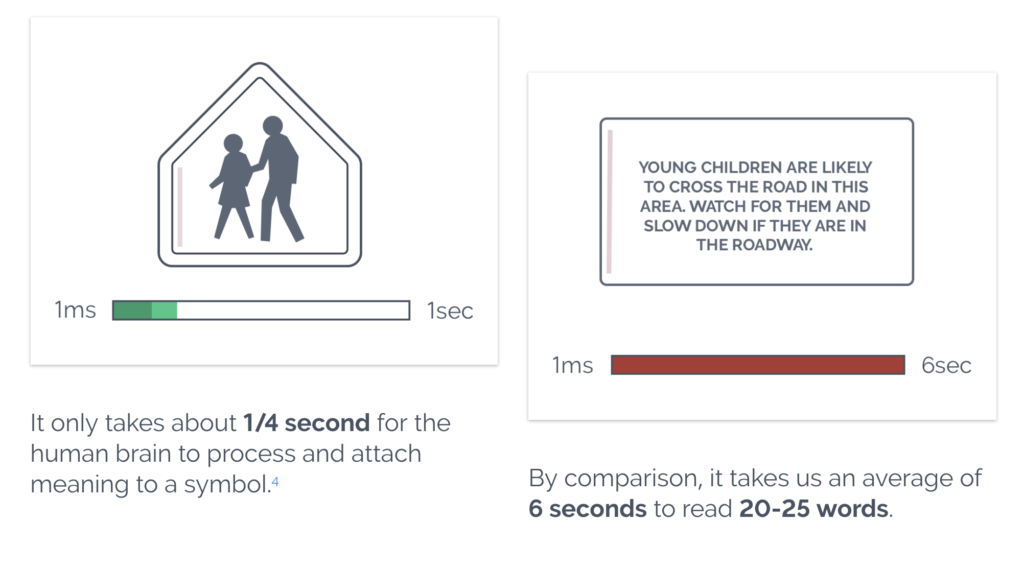
Rather than placing a long list of bullet points in each presentation frame, communicate your message via an image and a few words or lines of text. Your audience will find this far more interesting and memorable than 30 minutes of straight talking and giant blocks of text.
Just make sure you’re using relatable and high-quality images and illustrations , not cheesy stock photos or clip art. Weave them into your presentation cleanly and clearly. Make them large enough that your audience can read and understand them. Need help finding an attention-grabbing background for your design? Here are some of our favorites for you to center your visual metaphor around.
4. Make eye contact
One of the top presentation tips for connecting with an audience is to make eye contact with people. Smile and focus on individuals in the audience. Yes, you’ll need to glance at your presentation or computer screen occasionally as you navigate through your talk. But don’t turn your back on the audience, and don’t stare at your screen and read off a script.
This age-old public speaking tip can help you build rapport with your audience and also calm your nerves. Eye contact will allow your audience to better connect with you and your topic.
5. Use proper lighting
To make eye contact in the first place, it’s important to make sure the lighting in the room or auditorium isn’t so low that the audience can’t see your face, eyes, and body language. To truly engage your audience, you’ll need their focus on you. Dim the lights just enough that people can see your presentation screen clearly. Most screens today are of high enough quality that you can still make out the picture clearly with low-level lighting.
Another reason not to turn the lights off completely? It can put your audience to sleep.
6. Have a conversation
The best presentations are interactive . Approach yours as if you’re sitting down to chat over coffee with your audience members. Avoid sounding like you’re reading off a script or giving a lecture. Change the pitch, speed, and tone of your voice as you talk. Throw in real-life examples, humorous quips, or some emotion into your delivery. This can be challenging with serious or dry topics, but it’s key to keeping the audience nodding along instead of nodding off.
Using Prezi’s open, conversational presentation format makes this easy since you can quickly maneuver between topics depending on audience comments and the flow of the conversation.
7. Tie in social media
Create a hashtag around your presentation or your message, and encourage people to use it on social media. Some audience members will live tweet from a conference or a presentation, while others might prefer to express their opinions and feedback online versus in front of a live audience. Regardless, hashtags keep the conversation going and allow you to search for what people are saying about your talk. Interact with these mentions, either in real time during your presentation or after the fact.
8. Tell a story
People identify and connect with stories. These narratives also help people remember your message. Start with an interesting story or personal experience, or launch into one within five minutes of starting your presentation. Effective presentations are built around good storylines. Don’t just tell your story , though — show it. Prezi lets you design your presentation to be more like a movie or a conversation rather than a linear slide deck. This format allows you to zoom in on key points or reveal information to surprise your audience as you tell your story.
9. Be passionate and honest
To get your audience engaged with your topic, you need to be engaged with it, too. It’s not the audience’s job to motivate you; they expect you to motivate them. Be genuinely excited about what you’re presenting, and demonstrate that enthusiasm on stage. If you don’t believe in your core message, your audience won’t either. They’ll start to lose interest or confidence in what you’re saying. Tell and show your audience why this topic is important to you and why they should care. Be confident, honest, and passionate without going over the top.
10. Work the stage
Showing off your passion on your topic should also be reflected in the way you move around and command a stage. Don’t just stand behind a podium or stare at a screen. Go outside your comfort zone and walk around. You can even walk into the audience — anything to remove the barrier between you and those listening to you. Moving around will keep the audience’s eyes trained on you and make your presentation more animated and spontaneous.
Avoid doing things like crossing your arms, keeping your hands in your pockets or behind your back, or pacing back and forth across the stage. Be cognizant of your distracting tics and habits, and try to minimize those. Instead, make eye contact, use hand gestures, and display your natural body language. Be sure to practice in front of a mirror or a friendly audience to get comfortable with how you want to move before presenting on the big stage.
With Prezi, you can support your great content, visuals, presentation design, and message with an exciting storyline, delivery, and personal connection with the audience. Apply these 10 presentation tips to make your next one inspiring, engaging, and memorable.

Give your team the tools they need to engage
Like what you’re reading join the mailing list..
- Prezi for Teams
- Top Presentations
Transform Your Health Presentations: Strategies for Clear, Engaging Slides
Slideshow presentations can be helpful tools for health communicators. We use them to share knowledge with other professionals. We use them for patient education. And we use them for community outreach. But we know they can be overwhelming or just plain boring. This tipsheet offers advice to elevate your health communication by making compelling, memorable presentations:
- State your main finding in your title.
- Give your audience one takeaway per slide.
- Use text sparingly.
Read on to see these tips in action.
Tip 1: State your main finding in your title
This tip applies to academic presentations and TED talks alike. No matter the context, your title can draw people in . Key findings give potential audiences more info to go off as they decide whether to engage with your work. It might also capture more people’s interest to know the impact of your work. While it might take some getting used to, you can follow the example of real-world examples from leaders in the field. Nature research articles tend to use key findings as titles. And Nature news articles translate them into even shorter informative titles.
Example titles
Suppose we made a presentation titled, “Developing a battery of blood protein tests to predict patients’ mortality from multiple chronic diseases.” This might accurately describe our study. But it does not reflect our findings. Instead, we could use a shorter and more informative title like this Nature article: “ Proteomic aging clock predicts mortality and risk of common age-related diseases in diverse populations .” This might be fine for a conference of content-area experts. But for a broader audience, we might use less jargon, like this Nature news report on the research: “ Blood test uses ‘protein clock’ to predict risk of Alzheimer’s .”
Learn how to make compelling titles
- Use this guide from Nature to make compelling scientific presentations , including titles.
Tip 2: Give your audience one takeaway per slide.
We recommend one takeaway per slide, no matter your audience. Your slide should explicitly state this takeaway like a headline. And you should give your audience the smallest amount of info possible to support or illustrate the headline. This helps give your presentation a consistent structure. And it helps you avoid giving people too much information at once. Keeping things consistent and brief is good for accessibility and memorability.
Example slide organized around a takeaway
The following example slides are adapted from a study on slide design by Garner and Alley . The first slide displays a common slide setup. The heading describes a topic. The body states related facts. The images are decorative.

In contrast, the slide below displays an “assertion-evidence” setup. The heading states a takeaway. The body consists of an illustration to support the takeaway. The images now serve an illustrative purpose rather than just being decorative.

Learn how to streamline your slides
- Use tips from Penn State’s Science Communication Lab to make “assertion-evidence” slides .
- Use elevator pitch tips from the Harvard Center for Health Communication.
Tip 3: Use text sparingly
Your audience won’t pay attention to you and your slides at the same time, so make sure to:
- Use as little text as possible to avoid overloading your audience.
- Use images instead of text wherever you can.
- If you must use text, use short lists limited to 4 points.
If you like to use wordy slides as take-home resources for your audience, you can still create handouts separate from your presentations.
Example presentation
The presenter in the video below uses very little text. Her slides include photos, figures, and a quote. Even still, she tells a compelling story that gets across several important, complex concepts from her research.
Learn more about slide design
- Use our slide design checklist
- Read “ Ten simple rules for effective presentation slides ” by KM Naegle
This tipsheet offers advice on making memorable, accessible slideshow presentations:
- Create a compelling title based on your findings.
- Organize your presentation around takeaways.
- Organize your presentation around key images, rather than writing a lot of text for your slides.
This tipsheet is part of a series on clear communication. It bridges knowledge from health literacy, web accessibility, and journalism to help you elevate your health communication. Combine your clear design with clearer writing and accessible graphs for even more impact.
This tipsheet was prepared by Samuel R. Mendez . It was reviewed by Amanda Yarnell and Elissa Scherer .
News from the School

Nurturing student entrepreneurs

40 years after Bhopal disaster, suffering continues

Meet the Dean

Making health care more affordable

COMMENTS
2. It persuades your audience to take action. A presentation should be persuasive. This is especially true for business presentations and product demos. You might also want to appeal to your readers through emotions. 3. It educates your audience and empowers them to make informed decisions.
Audience engagement strategy no. 3: Use turning points. Even if you succeed in engaging your audience, listeners need guidance to stay on track. For this purpose, use distinct turning points to move them through the presentation so that you maintain audience engagement.
Audience engagement example #2. Tell a joke. Another simple way that you can forge a connection at the beginning of your presentation is by telling a joke. A joke is, in itself, a smart way to interact with audience members since it's a natural back and forth. It either asks the audience to answer a question (Why did the chicken cross the ...
In this piece, the author outlines three techniques — physical, mental, and linguistic — to engage your audience. Attention is our most precious commodity. In today's fast-paced world of ...
The Power of Audience Engagement: Strategies and Examples. Presentation Ideas • November 29th, 2023. Engaging your audience is vital to effective presentations, business interactions, and media communication. It's a powerful tool that fosters connection, enhances knowledge retention, and drives action. Research conducted on audience ...
1. Be Confident. Be grounded and confident to be yourself and then tell great stories. Use your voice and the stage to bring the stories alive. Your audience will connect to the emotion of the ...
1. Prezi. Prezi is renowned for its dynamic and non-linear presentation style, enabling users to craft visually stunning and interactive presentations. With an array of templates and animation effects, Prezi enhances audience engagement, making your presentations more captivating and memorable. 2.
Prezi, shown above, is a popular non-linear presentation tool. 7. Add in a short video. Billions of hours of YouTube are consumed each month and advertisers have identified videos as having a high retention rate for users. However very few presentations ever use videos to engage with their audience.
A better technique is what we call, "Think, Write, Share.". Have the audience think about the question that you ask. After a few seconds, have them write down possible answers. After the group has written quite a bit of content, only then do you ask them to share the content.
Showing your personality and sense of humor can lighten the mood and build a good rapport with the crowd. The audience is more likely to remember you if you make them laugh and in turn remember your ideas and key points. 6. Eye contact. The power of good eye contact can never be underestimated.
Maintain Eye Contact. Establish a connection with your audience through consistent eye contact. When you look directly at your listeners, it conveys confidence and sincerity. It also helps you gauge their reactions and adjust your presentation accordingly. Avoid constantly reading from notes or slides; instead, engage with your audience.
4. Play A Quiz! Another way to engage your audience more deeply in your presentation is by quizzing them! If you wish to quiz the audience to get an idea how of how familiar they are with the topic, you can add the quiz at the beginning of your speech. This can be a great bonding experience for them.
1. Ask Questions: Encourage audience participation by asking questions throughout your presentation. This turns your talk into a dialogue rather than a monologue and keeps your audience engaged. 2. Icebreakers: Start your presentation with an icebreaker to grab your audience's attention and set a positive tone.
Lighten the mood by incorporating some humor into your presentation to keep the audience engaged. Leo Rosten, an American Humorist, once said "Humour is the affectionate communication of insight." I'm sure the audience will be happy to listen to a joke or two during a presentation, especially those with heavy content. 7. Encourage interaction
Plan out the first topics carefully to properly introduce your argument. Add the essential information in the middle part of your presentation. Lastly, close your presentation with a summary of the main points and leave your audience with an afterthought. Also, plan when you're taking questions and for how long.
Presenting effectively involves careful preparation, understanding your audience, and delivering your message in an engaging manner. Here are some popular tips that can help you give a great presentation: Know Your Audience. Prepare Well. Write and Stick to a Script. Create an Engaging Slide Deck. Start Strong.
Some techniques engage your audience physically. Poll the audience and have them raise their hands. For longer presentations, consider a stretch break in between. Use humour - laughter is movement and it can shift the feel of a presentation and provide physical relief especially after mental or emotional demanding content.
Tell and show your audience why this topic is important to you and why they should care. Be confident, honest, and passionate without going over the top. 10. Work the stage. Showing off your passion on your topic should also be reflected in the way you move around and command a stage.
3 Embrace the pause. Under the cover of invisibility, online audiences can be a very passive lot. As a result, presenters have a tendency to go into long monologues that only further discourage participation and encourage tune-out. Make friends with the pause.
Tip 2: Give your audience one takeaway per slide. We recommend one takeaway per slide, no matter your audience. Your slide should explicitly state this takeaway like a headline. And you should give your audience the smallest amount of info possible to support or illustrate the headline. This helps give your presentation a consistent structure.